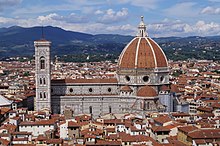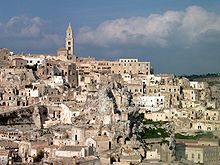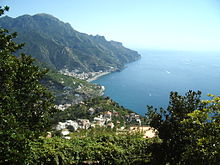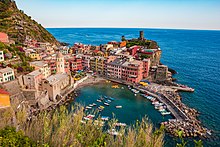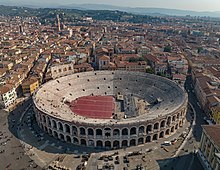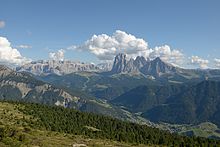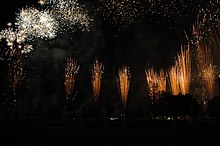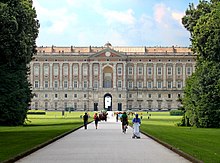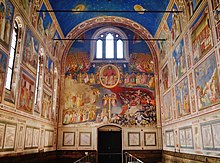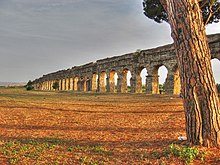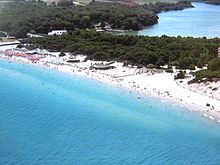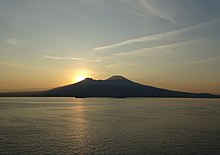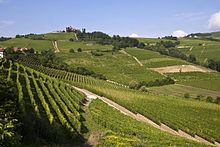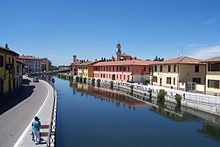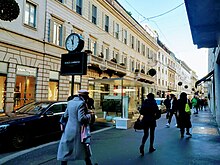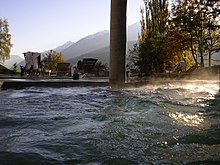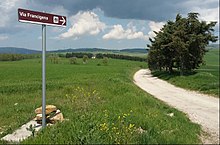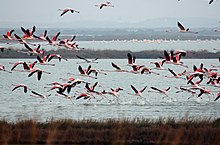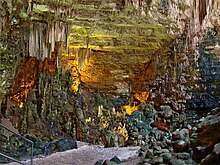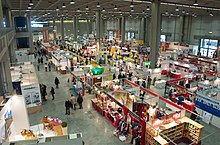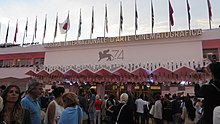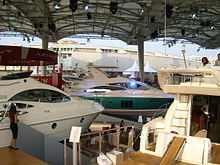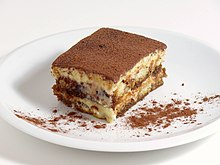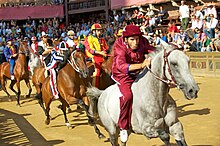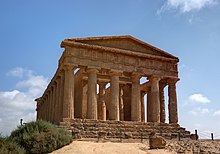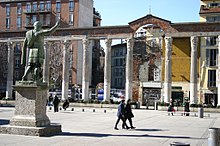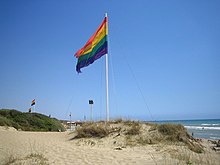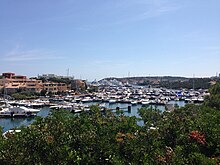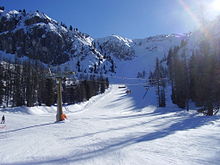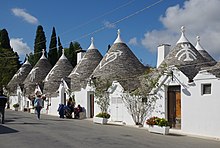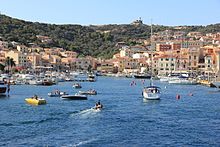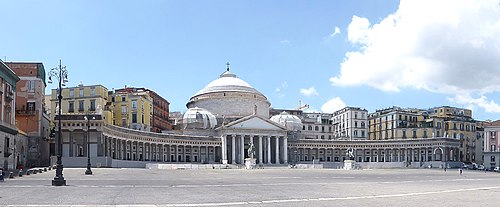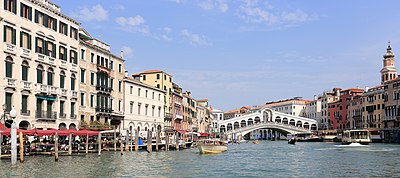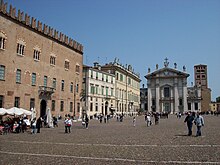이탈리아의 관광
Tourism in Italy
이탈리아의 관광은 그 나라의 경제 분야 중 하나이다.
ISTAT에 따르면, 이탈리아는 연간 6500만 명의 관광객으로 국제 관광 도착에서 5위를 차지하지만, 호텔 숙박으로는 스페인에 이어 두 번째이며, 외국인 방문객 숙박은 2억2천70만 명, 총 4억3천670만 명으로 집계되었다.이탈리아 중앙은행의 2018년 추산에 따르면 관광업은 국내총생산(GDP)의 5% 이상을 직접 창출하고 있으며(간접적으로 창출된 GDP를 고려하면 13%), [4][5]고용자의 6% 이상을 차지한다.
사람들은 수세기 동안 이탈리아를 방문했지만, 관광을 이유로 한반도를 가장 먼저 방문한 것은 17세기에 시작되어 18세기와 19세기에 [6]번성했던 그랜드 투어의 귀족들이었다.이 시기는 많은 영국인과 프랑스인이었던 유럽의 귀족들이 이탈리아를 주요 [6]여행지로 하여 유럽의 일부 지역을 방문했던 시기였다.이탈리아에게 이것은 고대 건축과 지역 문화를 연구하고 자연의 [7]아름다움을 감상하기 위한 것이었다.
오늘날 이탈리아 관광객들의 관심요소는 주로 문화, 요리, 역사, 패션, 건축, 예술, 종교 유적지 및 경로, 자연주의 미관, 나이트라이프, 수중 유적지, 스파 등이다.겨울과 여름 관광은 알프스 산맥과 아펜니 [8]산맥의 많은 지역에서 볼 수 있는 반면, 해변 관광은 [9]지중해를 따라 있는 해안 지역에서 널리 퍼져 있다.로마는 2017년 940만 명이 입국해 유럽에서 3위, 세계에서 12위를 차지했으며 밀라노는 680만 명의 [10]관광객으로 세계 27위다.게다가, 베니스와 플로렌스는 또한 세계 100대 여행지 중 하나이다.이탈리아는 세계에서 유네스코 세계문화유산이 가장 많은 나라이기도 하다.[11]이탈리아의 58개 유산 중 53개가 문화유산이고 5개가 [12]자연유산이다.
로마 제국, 중세, 르네상스 그리고 그 이후의 몇 세기 동안의 이탈리아 역사는 [13]관광객들을 끌어들이는 많은 문화 유물을 남겼다.일반적으로 이탈리아 문화유산은 4000여 개의 박물관, 6000여 개의 고고학 유적지, 8만5000여 개의 교회, 40,000여 개의 고궁 등 [14]각 대륙에 존재하는 모든 예술 자산의 6075%를 차지하기 때문에 세계에서 가장 크다.[15]2018년 현재 이탈리아의 문화공간(박물관, 명소, 공원, 기록보관소, 도서관 포함)은 6,610개에 이른다.이탈리아는 지중해의 [16]대표적인 크루즈 관광지입니다.
이탈리아에는 별 1개에서 별 5개까지 다양한 호텔이 있습니다.ISTAT에 따르면 2017년 한 해 동안 3만2988개의 호텔과 113만3452개의 객실, 223만9446개의 [17]침대가 있었다.비호텔 시설(캠프장, 관광촌, 임대시설, 농업관광 등)은 2017년 171,915개,[17] 침대수 279만8352개였다.해안 휴양지로의 관광객 흐름은 53%이다; 가장 시설이 잘 갖춰진 도시는 농가를 위한 그로세토, 야영지와 관광 마을을 위한 비에스테, 그리고 코르티나 암페초 산 오두막이다.[18][19]
역사
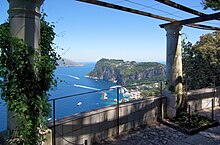
시작
사람들은 수세기 동안 이탈리아를 방문했지만, 관광을 이유로 한반도를 가장 먼저 방문한 것은 17세기에 시작되어 18세기와 19세기에 [6]번성했던 그랜드 투어의 귀족들이었다.
강력하고 영향력 있는 로마 제국의 수도로서, 로마는 지중해, 북아프리카, 영국 본토 그리고 서아시아의 일부를 포함한 제국 전역에서 수천 명의 도시와 나라로 끌어들였다.무역상들과 상인들은 세계 여러 곳에서 이탈리아로 왔다.제국이 476년에 멸망했을 때, 로마는 더 이상 유럽 정치와 문화의 중심지가 아니었다; 반면에, 로마가 유럽의 주요 순례 장소 중 하나로 남아있다는 것을 의미하는, 성장하는 기독교 종교를 지배하는 교황의 근거지였다.순례자들은 수 세기 동안, 그리고 오늘날까지도 이 도시에 왔을 것이고, 그것은 "관광" 또는 "종교 관광"에 해당하는 초기 단계였을 것이다.베니스, 피사, 제노바의 무역제국은 전 세계에서 몇몇 무역상, 사업가, 상인들 또한 정기적으로 이탈리아에 올 것이라는 것을 의미했다.16세기와 17세기 초에, 르네상스의 절정기와 함께, 이니고 존스 같은 몇몇 학생들이 이탈리아 건축을 공부하기 위해 이탈리아로 왔다.
그랜드 투어
진정한 "관광"은 그랜드 투어의 시작과 함께 17세기 후반 이탈리아에만 영향을 미쳤다.이 시기는 유럽 귀족들이 이탈리아를 주요 [6]여행지로 삼아 유럽 일부 지역을 방문한 시기였다.이탈리아에게 이것은 고대 건축과 지역 문화를 연구하고 자연의 [7]아름다움을 감상하기 위한 것이었다.그랜드 투어는 본질적으로 로마 가톨릭 신부 리처드 라셀에 의해 [20][21]1670년에 출판된 Voyage to Italy에 의해 촉발되었다.그랜드 투어로 인해, 관광은 훨씬 더 보편화되었고, 이탈리아는 수백만 [22]명의 사람들이 가장 원하는 여행지 중 하나가 되었다.일단 오늘날의 이탈리아에 들어가면, 이 관광객들은 토리노를 잠시 방문하는 것으로 시작할 것이다.가는 길에 밀라노도 인기 있는 관광지였지만, 그 도시로의 여행은 필수적이지 않았고, 몇 개는 그냥 지나쳤거나, 단지 짧은 시간 동안 머물렀습니다.만약 어떤 사람이 배를 타고 온다면, 그들은 제노바에 며칠 머물 것이다.그러나 북이탈리아의 주요 목적지는 베로나 비첸차 파두아 등 주변 도시들과 함께 중요한 [20]기착지로 여겨졌던 베네치아였다.
투어가 진행되면서, 토스카나 도시들은 또한 매우 중요한 여행지들이 되었다.플로렌스는 주요 관광지였고 시에나, 피사, 루카, 산 기미냐노와 같은 다른 토스카나 마을들도 중요한 여행지로 여겨졌다.그러나 중부 이탈리아에서 가장 눈에 띄는 기착지는 예술과 문화의 중심지이자 그랜드 [20]투어리스트에게 필수적인 도시였던 로마였다.나중에,[20] 그들은 나폴리 만으로 내려갔고, 1710년 그들이 발견된 이후, 폼페이와 헤르쿨라네움도 인기가 있었다.시칠리아는 이 산책로의 중요한 부분으로 여겨졌고 괴테와 같은 몇몇 사람들이 섬을 방문했다.
대중 관광
17세기부터 18세기까지 그랜드 투어는 주로 학자나 엘리트들을 위한 것이었다.그럼에도 불구하고, 1840년경,[20] 철도 운송이 도입되었고 그랜드 투어는 유행에서 약간 벗어나기 시작했다. 그래서, 대중 관광의 첫 번째 형태가 도입되었다.1840년대는 빅토리아 시대의 중산층이 그 나라를 여행했던 시기였다.몇몇 미국인들 또한 이탈리아를 방문할 수 있었고, 더 많은 관광객들이 한반도로 왔다.베네치아, 피렌체, 로마, 나폴리, 시칠리아와 같은 장소들은 여전히 최고의 명소로 남아있었다.
다른 많은 유럽인들처럼 이탈리아 사람들도 대중 교통에 크게 의존한다.이탈리아는 비교적 작은 나라이고 거리도 [23]줄어든다.
세기가 지날수록 문화적인 방문이 줄어들었고 이탈리아의 자연과 날씨를 찾아오는 관광객도 늘었다.리구리아 해안, 베네치아 주변, 투스카니 해안, 아말피 해안과 같은 최초의 해변 휴양지는 인기를 끌었다.이 여름 휴가의 유행은 산레모, 리도 디 베네치아, 비아레지오, 포르테 데 마르미 등 수많은 그랜드 호텔이 들어선 핀데시클 시대에 절정을 이뤘다.카프리, 이스키아, 프로치다, 엘바 등의 섬들이 인기를 끌었고 코모 호수, 마조레, 가르다 같은 북부 호수들이 더 자주 방문되었다.이탈리아 관광은 대공황과 경제 위기로 인해 몇몇 사람들이 더 이상 이탈리아를 방문할 여유가 없었던 1920년대 후반과 1930년대 초반까지 큰 인기를 누렸다; 증가하는 정치적 불안은 더 적은 관광객을 의미했다.스콜피온과 같은 오래된 관광 그룹만이 살아남았다.
1929년경부터 시작된 관광의 큰 부진과 제2차 세계대전 이후 지속된 이탈리아는 이탈리아 경제의 기적과 생활수준의 향상과 함께 인기 있는 휴양지로서의 지위를 되찾았다; 라 돌체 비타와 같은 영화들은 해외에서 성공을 거뒀고, 그들의 목가적인 삶에 대한 묘사는 이탈리아의 국제 사회를 높이는 데 도움을 주었다.onal 프로파일이쯤 되면 수입이 많아지면서 이탈리아인들도 휴가를 갈 여유가 생겼다. 해안가 휴양지, 특히 로마냐에서 방문객이 급증했다.1960년대에 값싼 호텔과 펜션(호스텔)이 많이 지어졌고, 부유해진 지금은 이탈리아 서민 가정도 해안가 어딘가에서 휴가를 보낼 여유가 생겼다.1960년대 후반에는 산악 휴일과 스키에도 큰 인기를 끌었습니다. 피에몬트와 아오스타 계곡에는 많은 스키 리조트와 오두막이 지어지기 시작했습니다.1970년대는 또한 지중해 여행지들이 전세계 관광객들의 증가를 보였기 때문에, 감상적인 여행인 빌로레시의 옛 매력을 찾아 이탈리아로 외국인 관광객들의 물결을 몰고 왔다.
그럼에도 불구하고, 1970년대 후반과 1980년대 초반까지, 경제 위기와 정치적 불안은 극동이나 남아메리카의 여행지가 인기를 [24]끌면서 이탈리아 관광 산업에 심각한 침체가 있었다는 것을 의미했다.그러나 1980년대 후반과 1990년대 초반에는 밀라노와 같은 도시들이 더 인기 있는 여행지가 되면서 관광산업이 다시 인기를 얻었다.밀라노는 세계적인 패션 수도로서 입지를 다지고 있기 때문에 관광객이 증가했다.
토지 및 기후
지리

이탈리아는 남유럽에 위치해 있으며, 위도 35°와 47° N, 경도 6°와 19° E 사이의 서유럽의 [25]일부로 여겨진다.이탈리아는 북쪽으로 스위스, 프랑스, 오스트리아, 슬로베니아와 국경을 접하고 있으며, 포 계곡과 베네치아 평원을 둘러싸고 있는 알파인 분수령으로 대략 구분되어 있습니다.남쪽은 이탈리아 반도 전체가 아펜니노 산맥과 지중해 섬인 시칠리아 섬과 사르디니아 섬으로 이루어져 있다.주권국가인 산마리노와 바티칸 시티는 이탈리아 [26][27]내 에워싸고, 캄피오네 디탈리아는 스위스에 [28]있는 이탈리아인 외톨이다.
이탈리아는 북반구의 일부입니다.한국의 총 면적은 301,230 평방 킬로미터이며, 이 중 294,0202 킬로미터는 육지이고 7,2102 킬로미터는 [29]물입니다.이탈리아는 섬을 포함해 아드리아 해, 이오니아 해, 티레니아 해, 리구리아 해, 사르디니아 해, 시칠리아 해협에 7,900km(4,900mi), 오스트리아(4,30km), 슬로베니아(2,332km)와 국경을 접하고 있다.나머지는 산마리노(39km)와 바티칸시티(3.2km)가 차지하고 있다.[29]
기후.
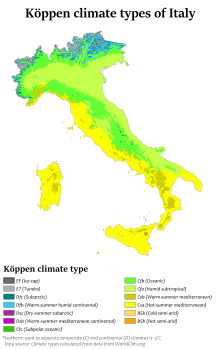
이탈리아의 기후는 북쪽을 제외한 모든 면에서 이탈리아를 둘러싸고 있는 지중해의 거대한 수역의 영향을 받는다.이러한 바다는 이탈리아의 열과 습도의 저수지가 된다.남부 온대 내에서, 그들은 특히 고기압 조건에서의 완화 효과를 느끼는 경향이 있는 지역의 지형학 때문에 국지적인 차이를 가지고 지중해 기후라고 불리는 특정한 기후를 결정한다.
반도의 길이와 대부분 산악지대로 인해 이탈리아의 기후는 매우 다양하다.이탈리아 내륙 북부 지역(예: 토리노, 밀라노 및 볼로냐)은 비교적 서늘하고 중위도 중간 버전의 습한 아열대 기후(쾨펜 기후 분류 Cfa)를 가지고 있는 반면, 리구리아의 해안 지역과 피렌체의 남쪽 반도는 일반적으로 지중해 기후 프로파일(쾨펜 기후 분류 Csa)[30]에 적합하다.
해안의 상황은 내륙의 상황과 다르며, 특히 고도가 높은 겨울에는 춥고 습하며 눈이 자주 내린다.해안 지역은 겨울은 포근하고 여름은 따뜻하고 일반적으로 건조하지만, 저지대 계곡은 여름에 매우 덥습니다.북쪽과 남쪽 사이에는 특히 겨울 동안 기온의 큰 차이가 있을 수 있습니다. 일부 겨울 날에는 -2°C(28°F)이고 밀라노에서는 눈이 내릴 수 있지만, 반면 로마에서는 8°C(46.4°F), 팔레르모에서는 20°C(68°F)입니다.여름엔 기온차가 덜 심해요.
운송
국도망과 관련하여, 2002년 이탈리아에는 Atlantia가 운영하는 6,487km(4,031mi)의 자동차 전용도로를 포함하여 668,721km(415,524mi)의 정비 가능한 도로가 있었다.
전국 철도망 또한 광범위하며, 특히 북쪽의 경우 총 16,862km에 69%가 전기화되고 4,937대의 기관차와 철도 차량이 순환합니다.세계에서 12번째로 크고 국영 Ferrovie dello Stato가 운영하며, 철도 선로와 인프라는 Rete Ferrovia Italiana가 관리합니다.많은 사철들이 존재하고 대부분 통근형 서비스를 제공하지만, 국철은 또한 주요 도시와 연결되는 정교한 고속 철도 서비스를 제공한다.
이탈리아는 2011년 [31]유럽 전체 승객의 약 10%인 약 1억4800만 명의 항공 운송 승객으로 유럽에서 다섯 번째이다.이탈리아에는 약 130개의 공항이 있으며, 그 중 99개는 포장된 활주로(로마의 레오나르도 다빈치 국제 공항과 밀라노의 말펜사 국제 공항)가 있다.
2004년에는 지중해에서 가장 크고 화물 톤수가 세 번째로 많은 제노바 항을 포함한 43개의 주요 항구가 있었다.아시아와 동아프리카와 연결되는 해상 실크로드의 중요성이 높아짐에 따라, 최근 몇 년 동안 이탈리아 중부 및 동유럽 항구가 중요해졌다.특히 지중해 최북단의 심해 항구인 트리에스테는 이탈리아, 아시아, 유럽의 [32][33]투자 대상이다.국가 내륙 수로 네트워크는 1,477km(918mi)의 항행 가능한 강과 수로들로 구성되어 있습니다.
관광 플로우
이탈리아의 관광객 흐름은 겨울에는 크리스마스와 설날 연휴,[34] 봄에는 [35]부활절 연휴, 여름에는 기후가 [36]좋기 때문에 최고조에 달합니다.
자체 여행객에게 관광 흐름의 정점도 3개의 국내 시민 휴일의 경우에 기록된 경우 페스타 델 liberazione(4월 25일), 페스타 데이 lavoratori(5월 1일)과 페스타 델라 Repubblica(26월)[37][38]뿐만 아니라 3명의 종교 휴일에, Ferragosto은 Ognissanti(11월 1일)[40]과 번째(8월 15일)[39].e페스타 dell'Immacolata Concezione ([41]12월 8일).
통계 정보
국가별 도착
2019년 이탈리아에 도착한 대부분의 방문객은 다음 국가의 [42]시민이다.
| # | 나라 | 도착. |
|---|---|---|
| 1 | 12.832.334 | |
| 2 | 6.092.754 | |
| 3 | 4.744.412 | |
| 4 | 3.695.112 | |
| 5 | 3.167.960 | |
| 6 | 3.027.331 | |
| 7 | 2.648.203 | |
| 8 | 2.243.621 | |
| 9 | 2.137.760 | |
| 10 | 1.778.720 | |
| 11 | 1.593.692 | |
| 12 | 1.406.696 | |
| 13 | 1.282.925 | |
| 13 | 1.258.901 | |
| 15 | 1.133.118 | |
| 16 | 1.116.846 | |
| 17 | 1.049.285 | |
| 18 | 1.006.673 | |
| 19 | 948.176 | |
| 20 | 900.502 | |
| 21 | 797.381 | |
| 22 | 719.212 | |
| 23 | 697.407 | |
| 24 | 631.748 | |
| 25 | 610.697 | |
| 26 | 610.117 | |
| 27 | 605.415 | |
| 28 | 593.319 | |
| 29 | 537.669 | |
| 30 | 459.011 | |
| 31 | 413.514 | |
| 32 | 410.857 | |
| 33 | 404.344 | |
| 34 | 390.789 | |
| 35 | 362.967 | |
| 36 | 353.276 | |
| 37 | 330.638 | |
| 38 | 294.825 | |
| 39 | 267.366 | |
| 40 | 242.836 | |
| 41 | 239.772 | |
| 42 | 209.352 | |
| 43 | 190.346 | |
| 44 | 168.894 | |
| 45 | 140.019 | |
| 46 | 128.442 | |
| 47 | 110.147 | |
| 48 | 94.622 | |
| 49 | 93.279 | |
| 50 | 83.236 | |
| 51 | 78.398 | |
| 52 | 48.017 | |
| 53 | 43.216 | |
| 54 | 34.296 | |
| 도착 총수 | 65.010.220 |
국가별 숙박 횟수
| 순위 | 나라 | 숙박일수 |
|---|---|---|
| 1 | 58.699.396 | |
| 2 | 16.302.928 | |
| 3 | 13.842.473 | |
| 4 | 13.674.263 | |
| 5 | 10.806.529 | |
| 6 | 10.320.382 | |
| 7 | 9.520.238 | |
| 8 | 6.203.982 | |
| 9 | 5.819.444 | |
| 10 | 5.789.755 | |
| 11 | 5.355.907 | |
| 12 | 4.751.383 | |
| 13 | 4.127.567 | |
| 14 | 3.058.530 | |
| 15 | 2.881.036 | |
| 16 | 2.824.686 | |
| 17 | 2.765.252 | |
| 18 | 2.665.209 | |
| 19 | 2.544.362 | |
| 20 | 2.372.891 | |
| 21 | 2.210.468 | |
| 22 | 1.815.223 | |
| 23 | 1.247.398 | |
| 24 | 903.868 | |
| 17.437.507 | ||
| 5.311.276 | ||
| 총 | 220.662.684 |
이탈리아의 2017년 방문객 숙박은 총 4억2063만 명이었고, 이 중 2억1066만 명이 외국인 투숙객(50.08%)이었다.호텔, 호스텔 또는 클리닉에서 3천704만 밤을 보낸 베니스가 가장 [43]많은 방문객을 보유하고 있다.
방문자 수별 이탈리아 지역
지역 데이터에 따르면 2019년 이탈리아의 관광 재산은 4억3600만 명(2억1600만 명, 비거주자 [44]2억2000만 명)에 달했다.
관광객 숙박시설에서 7100만 밤을 보낸 베네토는 방문객 수가 가장 많고 유럽 [45][46]6위입니다.
아래 표는 이탈리아에서 방문자 수가 가장 많은 지역(2019년 기준 데이터)
| # | 지역 | 총박수 | 거주자. | 비거주자 |
|---|---|---|---|---|
| 1 | 71.236.630 | 23.068.000 | 48.168.630 | |
| 2 | 52.074.506 | 20.941.947 | 31.132.559 | |
| 3 | 48.077.301 | 22.317.283 | 25.760.018 | |
| 4 | 40.647.799 | 29.748.437 | 10.611.605 | |
| 5 | 40.482.939 | 16.229.378 | 24.253.561 | |
| 6 | 39.029.255 | 14.637.466 | 24.391.789 | |
| 7 | 22.013.245 | 11.383.367 | 10.629.878 | |
| 8 | 15.441.469 | 11.598.644 | 3.842.825 | |
| 9 | 15.145.885 | 7.418.767 | 7.727.118 | |
| 10 | 15.114.931 | 7.483.403 | 7.631.528 | |
| 11 | 15.074.888 | 8.932.884 | 6.142.004 | |
| 12 | 14.889.951 | 8.351.424 | 6.538.527 | |
| 13 | 10.370.800 | 8.647.855 | 2.417.288 | |
| 14 | 9.509.423 | 7.315.264 | 2.194.159 | |
| 15 | 9.052.850 | 3.898.039 | 5.154.811 | |
| 16 | 6.176.702 | 5.383.234 | 793.468 | |
| 17 | 5.889.224 | 3.810.497 | 2.078.727 | |
| 18 | 3.625.616 | 2.113.001 | 1.512.615 | |
| 19 | 2.733.969 | 2.392.796 | 296.230 | |
| 20 | 448.600 | 127.283 | 341.173 | |
| 436.739.271 | 216.076.587 | 220.662.684 |
방문자 수별 이탈리아 주/수도권 도시
아래 표는 이탈리아에서 가장 많이 방문한 도/도시를 나타낸 표이다(2017년 기준 데이터).
| 순위 | 주/광역시 | 일박수 2017년에[43] | 누구의 외국[43] 방문자 | 지역 |
|---|---|---|---|---|
| 1 | 베네치아 | 37,042,454 | 27,477,075 | |
| 2 | 볼자노/보젠 | 32,400,662 | 22,125,350 | |
| 3 | 로마 | 29,833,225 | 7,046,098 | |
| 4 | 트렌토 | 17,776,030 | 7,412,103 | |
| 5 | 베로나 | 17,293,792 | 13,388,082 | |
| 6 | 리미니 | 15,967,490 | 3,808,354 | |
| 7 | 밀라노 | 15,468,199 | 9,291,198 | |
| 8 | 플로렌스 | 14,716,466 | 10,780,968 | |
| 9 | 나폴리 | 13,161,395 | 7,247,964 | |
| 10 | 브레시아 | 10,463,688 | 7,472,887 | |
| 11 | 리보르노 | 8,663,572 | 3,491,172 | |
| 12 | 사사리 | 7,492,538 | 4,162,225 | |
| 13 | 토리노 | 7,046,219 | 1,842,052 | |
| 14 | 라벤나 | 6,698,702 | 1,381,666 | |
| 15 | 살레르노 | 6,029,649 | 2,098,781 | |
| 16 | 사보나 | 5,717,487 | 1,471,811 | |
| 17 | 그로세토 | 5,714,546 | 1,601,673 | |
| 18 | 파두아 | 5,479,110 | 2,426,489 | |
| 19 | 우디네 | 5,371,339 | 3,027,318 | |
| 20 | 포를리체세나 | 5,357,398 | 1,027,558 | |
| 21 | 레체 | 5,048,739 | 949,521 | |
| 22 | 시에나 | 4,928,092 | 2,880,531 | |
| 23 | 페루자 | 4,689,356 | 1,699,019 | |
| 24 | 볼로냐 | 4,607,456 | 2,101,001 | |
| 25 | 포기아 | 4,503,604 | 697,073 | |
| 26 | 제노바 | 4,082,817 | 1,945,743 | |
| 27 | 벨루노 | 3,806,806 | 1,208,331 | |
| 28 | Aosta/Aoste | 3,599,402 | 1,434,422 | |
| 29 | 루카 | 3,546,044 | 1,696,020 | |
| 30 | 메시나 | 3,493,859 | 2,153,932 | |
| 31 | 테라모 | 3,419,387 | 523,718 | |
| 32 | 페사로 우르비노 | 3,295,759 | 729,067 | |
| 33 | 코센자 | 3,290,418 | 369,693 | |
| 34 | 임페리아 | 3,202,619 | 1,324,925 | |
| 35 | 베르바니아 | 3,095,668 | 2,443,754 | |
| 36 | 코모 | 3,088,807 | 2,375,038 | |
| 37 | 피사 | 3,032,756 | 1,632,412 | |
| 38 | 페라라 | 3,020,136 | 1,142,220 | |
| 39 | 팔레르모 | 2,981,947 | 1,703,615 | |
| 40 | 안코나 | 2,954,206 | 536,167 | |
| 이탈리아의 나머지 지역 | 79,247,316 | 42,531,760 | ||
| 총 | 420,629,155 | 210,658,786 | ||
방문자 수에 따른 이탈리아의 도시
아래 표는 이탈리아에서 가장 많이 방문한 도시 목록(2019년 기준 [47]데이터)
| # | 코무네 | 지역 | 도도부현 | 밤 |
|---|---|---|---|---|
| 1 | 로마 | 라치오 | 로마 | 30,980,083 |
| 2 | 베네치아 | 베네토 | 베네치아 | 12,948,519 |
| 3 | 밀라노 | 롬바르디아 | 밀라노 | 12,474,278 |
| 4 | 플로렌스 | 투스카니 | 플로렌스 | 10,955,345 |
| 5 | 리미니 | 에밀리아로마냐 주 | 리미니 | 7,548,135 |
| 6 | 카발리노 트레포르티 | 베네토 | 베네치아 | 6,269,451 |
| 7 | 산 미켈레 알 타글리아멘토 | 베네토 | 베네치아 | 5,851,482 |
| 8 | 제솔로 | 베네토 | 베네치아 | 5,438,519 |
| 9 | 카오레 | 베네토 | 베네치아 | 4,319,483 |
| 10 | 나폴리 | 캄파니아 주 | 나폴리 | 3,765,485 |
| 11 | 리치오네 | 에밀리아로마냐 주 | 리미니 | 3,632,025 |
| 12 | 토리노 | 피에몬테 | 토리노 | 3,626,036 |
| 13 | 라지즈 | 베네토 | 베로나 | 3,606,249 |
| 14 | 리그나노 사비아도로 | 프리울리베네치아줄리아 | 우디네 | 3,594,091 |
| 15 | 세르비아 | 에밀리아로마냐 주 | 라벤나 | 3,468,948 |
| 16 | 체세나티코 | 에밀리아로마냐 주 | 포를리체세나 | 3,403,237 |
| 17 | 불로뉴 | 에밀리아로마냐 주 | 볼로냐 | 3,188,040 |
| 18 | 소렌토 | 캄파니아 주 | 나폴리 | 2,756,578 |
| 19 | 베로나 | 베네토 | 베로나 | 2,743,943 |
| 20 | 라벤나 | 에밀리아로마냐 주 | 라벤나 | 2,495,943 |
| 21 | 페시에라 델 가르다 | 베네치아 | 베로나 | 2,379,705 |
| 22 | 벨라리아이지아 마리나 | 에밀리아로마냐 주 | 리미니 | 2,216,032 |
| 23 | 바르돌리노 | 베네토 | 베로나 | 2,101,596 |
| 24 | 코마키오 | 에밀리아로마냐 주 | 페라라 | 1,998,304 |
| 25 | 아바노 테르메 | 베네토 | 파두아 | 1,987,421 |
| 26 | 비에스테 | 아풀리아 | 포기아 | 1,915,749 |
| 27 | 제노바 | 리구리아 | 제노바 | 1,905,777 |
| 28 | 피사 | 투스카니 | 피사 | 1,859,653 |
| 29 | 캣토리카 | 에밀리아로마냐 주 | 리미니 | 1,848,353 |
| 30 | 파두아 | 베네토 | 파두아 | 1,657,672 |
| 31 | 몬테카티니 테르메 | 투스카니 | 피스토이아 | 1,629,602 |
| 32 | 팔레르모 | 시칠리아 | 팔레르모 | 1,594,187 |
| 33 | 리바 델 가르다 | 트렌티노알토아디게/수트티롤 | 트렌토 | 1,590,189 |
| 34 | 카스텔로토 | 트렌티노알토아디게/수트티롤 | 볼자노 | 1,584,220 |
| 35 | 카스틸리오네 델라 페스카이아 | 투스카니 | 그로세토 | 1,506,463 |
| 36 | 그라도 | 프리울리베네치아줄리아 | 고리치아 | 1,398,262 |
| 37 | 치오기아 | 베네토 | 베네치아 | 1,376,237 |
| 38 | 리비뇨 | 롬바르디아 | 손드리오 | 1,337,223 |
| 39 | 포리오 | 캄파니아 주 | 나폴리 | 1,295,862 |
| 40 | 셀바 디 발 가르데나 | 트렌티노알토아디게/수트티롤 | 볼자노 | 1,294,036 |
| 41 | 이스키아 | 캄파니아 주 | 나폴리 | 1,236,669 |
| 42 | 시르미오네 | 롬바르디아 | 브레시아 | 1,209,423 |
| 43 | 아르자체나 | 사르데냐 | 사사리 | 1,209,220 |
| 44 | 산빈첸조 | 투스카니 | 리보르노 | 1,198,640 |
| 45 | 피우미치노 | 라치오 | 로마 | 1,180,562 |
| 46 | 바디아 | 트렌티노알토아디게/수트티롤 | 볼자노 | 1,178,014 |
| 47 | 리모네 술 가다 | 롬바르디아 | 브레시아 | 1,167,770 |
| 48 | 오르베텔로 | 투스카니 | 그로세토 | 1,165,731 |
| 49 | 메라노 | 트렌티노알토아디게/수트티롤 | 볼자노 | 1,148,867 |
| 50 | 아시시 | 움브리아 | 페루자 | 1,146,596 |
방문자 수에 따른 이탈리아 고고학 유적지와 박물관
아래 표는 이탈리아에서 가장 많이 방문한 유적지와 박물관을 표시한 표이다(2019년 [48][49]기준 자료).
| # | 위치 | 도시 | 방문객들 | 지역 |
|---|---|---|---|---|
| 1 | 콜로세움 고고학 공원 | 로마 | 7,617,649 | |
| 2 | 바티칸 박물관 | 로마 | 6,756,000 | |
| 3 | 우피치 | 플로렌스 | 4,391,861 | |
| 4 | 폼페이 고고학 공원 | 폼페이 | 3,933,079 | |
| 5 | 갤러리아 델아카데미아 | 플로렌스 | 1,704,776 | |
| 6 | 산탄젤로 성 | 로마 | 1,207,091 | |
| 7 | 이지오 박물관 | 토리노 | 853,320 | |
| 8 | 베나리아 궁전 | 베나리아 레알 | 837,093 | |
| 9 | 카세르타 왕궁 | 카세르타 | 728,231 | |
| 10 | 하드리아누스의 빌라와 빌라 데스테 | 티볼리 | 721,574 | |
| 11 | 국립 고고학 박물관 | 나폴리 | 670,594 | |
| 12 | 바르젤로 | 플로렌스 | 644,569 | |
| 13 | 갤러리아 보르헤세 | 로마 | 572,976 | |
| 14 | 허큘라네움 고고학 공원 | ercolano | 558,962 | |
| 15 | 토리노 왕립 박물관 | 토리노 | 492,049 | |
| 16 | 세나콜로 빈치아노 | 밀라노 | 445,728 | |
| 17 | 파이스툼 고고학 공원 | 페스툼 | 443,743 | |
| 18 | 피나코테카 디 브레라 | 밀라노 | 417,976 | |
| 19 | 두칼 궁전 | 만토바 | 346,462 | |
| 20 | 나치오날레 로마노 박물관 | 로마 | 323,750 | |
| 21 | 오스티아 안티카 고고학 공원 | 로마 | 322,099 | |
| 22 | 베네치아 국립 고고학 박물관 | 베네치아 | 316,283 | |
| 23 | 스칼리제로 성 | 시르미오네 | 308,459 | |
| 24 | 미라마레 성 | 트리에스테 | 307,177 | |
| 25 | 갤러리 델아카데미아 | 베네치아 | 304,999 | |
| 26 | 갤러리아 나지오날레 델레 마르체 | 우르비노 | 272,521 | |
| 27 | 나폴리 왕궁 | 나폴리 | 272,116 | |
| 28 | 카스텔델몬테 | 안드리아 | 269,794 | |
| 29 | 산텔모 성 | 나폴리 | 266,971 | |
| 30 | 카라칼라 목욕탕 | 로마 | 258,486 | |
| 31 | 카포디몬테 박물관 | 나폴리 | 252,770 |
방문자 수에 따른 이탈리아 교회
아래는 이탈리아에서 가장[50] 많이 방문하는 교회들이 있는 테이블이다.
| # | 교회 | 도시 | 지역 |
|---|---|---|---|
| 1 | 성 베드로 대성당 | 로마 | |
| 2 | 밀라노 대성당 | 밀라노 | |
| 3 | 피렌체 대성당 | 플로렌스 | |
| 4 | 시스티나 성당 | 로마 | |
| 5 | 파두아의 성 안토니우스 성당 | 파두아 | |
| 6 | 성모 마리아 마조르 대성당 | 로마 | |
| 7 | 산타 마리아 노벨라 대성당 | 플로렌스 | |
| 8 | 산타 크로체 대성당 | 플로렌스 | |
| 9 | 팔레르모 대성당 | 팔레르모 | |
| 10 | 성 요한 라테란의 대성당 | 로마 | |
| 11 | 성 마르코 대성당 | 베네치아 | |
| 12 | 몬렐레 대성당 | 몬레루 | |
| 13 | 산타 마리아 인 트라스테베레 대성당 | 로마 | |
| 14 | 산니콜라 대성당 | 바리 | |
| 15 | 산타 마리아 델레 그라지 성당 | 밀라노 | |
| 16 | 성 밖의 성 바오로 대성당 | 로마 | |
| 17 | 모데나 대성당 | 모데나 | |
| 18 | 나폴리 대성당 | 나폴리 | |
| 19 | 빈콜리의 산 피에트로 대성당 | 로마 | |
| 20 | 산앰브로지오 대성당 | 밀라노 |
관광객의 관심 요인
이탈리아에 [51]대한 관광의 관심을 이끄는 많은 요소들이 있다.
예술문화관광
이탈리아는 서구 문명의 발상지이자 문화 초강대국으로 꼽힌다.[52]1861년 최종적으로 통일될 때까지 수세기 동안 정치와 지리적으로 구분된 이탈리아의 문화는 많은 지역 관습과 권력과 [53]후원의 지역 중심지에 의해 형성되어 왔다.이탈리아는 수세기 동안 서구 문화에서 중심적인 역할을 해왔고 여전히 문화적 전통과 예술가로 인정받고 있다.중세와 르네상스 시대에는 많은 궁정들이 건축가, 예술가, 학자들을 끌어들이기 위해 경쟁했고, 따라서 기념물, 그림, 음악, 그리고 문학의 유산을 만들어냈다.이러한 법원의 정치적, 사회적 고립에도 불구하고, 이탈리아는 [54]유럽의 문화적, 역사적 유산에 상당한 기여를 했다.또한 이탈리아 디아스포라 동안 수많은 이탈리아인들이 다른 곳으로 이주했기 때문에, 이 나라는 세계적으로 폭넓은 문화적 영향을 끼쳤다.
The country boasts several world-famous cities. Rome was the ancient capital of the Roman Empire, the seat of the Pope of the Catholic Church, the capital of reunified Italy and the artistic, cultural and cinematographic centre of world relevance. Florence was the heart of the Renaissance, a period of great achievements in the arts at the end of the Middle Ages.[55] Other important cities include Turin, which used to be the capital of Italy, and is now one of the world's great centres of automobile engineering. Milan is the industrial and financial capital of Italy and one of the world's fashion capitals. Venice, the former capital of a major financial and maritime power from the Middle Ages to the early modern period, with its intricate canal system attracts tourists from all over the world, especially during the Venetian Carnival and the Biennale. Naples, with the largest historic city centre in Europe and the oldest continuously active public opera house in the world (Teatro di San Carlo). Bologna is the main transport hub of the country, as well as the home of the oldest university in the world and of a worldwide famous cuisine.[56]
Italian art has influenced several major movements throughout the centuries and has produced several great artists, including painters, architects and sculptors. Italy has a vast and important historical heritage,[57] both in terms of the number of artefacts, as well as in terms of conservation, and in terms of intrinsic artistic-cultural value. For example, Italy boasts the largest number of sites indicated in the UNESCO World Heritage List.[58] In general, the Italian cultural heritage is the largest in the world since it consists of 60% to 75% of all the artistic assets that exist on each continent,[14] with over 4,000 museums, 6,000 archaeological sites, 85,000 historic churches and 40,000 historic palaces, all subject to protection by the Italian Ministry of Culture.[15]
In 2013, the value of the artistic and cultural heritage alone was estimated at 5.4% of Italian GDP, approximately €75.5 billion, capable of employing approximately 1.4 million workers.[59] According to the Eurostat report of 2019, Italian tourism is first in Europe in terms of the number of jobs generated (4.2 million) and third for the average visitor expenditure and the share of revenues of the national sector compared to the European total (€48 billion, 12% of the total).[60][61]
There are numerous technology parks in Italy such as the Science and Technology Parks Kilometro Rosso (Bergamo), the AREA Science Park (Trieste), The VEGA-Venice Gateway for Science and Technology (Venezia), the Toscana Life Sciences (Siena), the Technology Park of Lodi Cluster (Lodi), and the Technology Park of Navacchio (Pisa),[62] as well as science museums such as the Museo Nazionale Scienza e Tecnologia Leonardo da Vinci in Milan, the Natural History Museum in Milan, the Città della Scienza in Naples and the Institute and Museum of the History of Science in Florence.
Seaside tourism
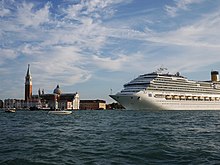
Four different seas surround Italy in the Mediterranean Sea from three sides: the Adriatic Sea in the east,[63] the Ionian Sea in the south,[64] and the Ligurian Sea and the Tyrrhenian Sea in the west.[65] Including islands, Italy has a coastline of over 8,000 kilometres (5,000 mi).[66] There are numerous famous coastal stretches.[67]
The Italian Riviera includes nearly all of the coastline of Liguria, extending from the border with France near Ventimiglia eastwards to Capo Corvo, which marks the eastern end of the Gulf of La Spezia.[68][69] Italian coasts also include the Amalfi Coast, Cilentan Coast, Cinque Terre, Coast of the Gods, Costa Verde, Riviera delle Palme, Riviera del Brenta, Costa Smeralda, and Trabocchi Coast, in addition to the bays Venetian Lagoon, Augusta Bay, Bay of Naples and Liscia di Vacca.
Notable beaches includes Baia Domizia in Sessa Aurunca and Cellole, Citara in Forio, Cala Fuili in Cala Gonone, Poetto in Cagliari, Spiaggia del Bacan in Venice, Cala Goloritze in Baunei, Baia delle Zagare in Vieste, Cavoli Beach in Elba, La Sorgente Beach in Portoferraio, Cala dei Gabbiani in Baunei, Cala Cipolla beach in Chia, Cauco Beach in Maiori.[70]
Noteworthy seaside locations includes Taormina, Alghero, Positano, Otranto, Tropea, Porto Santo Stefano, Sirolo, Vieste, Sperlonga, Cesenatico, Sestri Levante, Vasto, Termoli, Maratea, Bibione, Muggia, Amalfi, Atrani, Camogli, Capo Rizzuto, Castiglioncello, Cefalù, Gallipoli, Lerici, Manarola, Monterosso al Mare, Pisciotta, Polignano a Mare, Portofino, Praiano, Ravello, Sciacca, Scilla, Sorrento, Vernazza.[67][71]
Beaches and cliffs are dotted with various accommodation facilities, such as bathing establishments, hotels and restaurants, resorts, agritourism, night and day gathering centres, parks, piers and marinas, as well as numerous historic and artistic centres, which combine an interest in the bathing activities to those for leisure, nature and art.
The Italian seaports are docking points for cruise tourism.[16] Italy is the leading cruise tourism destination in the Mediterranean Sea.[16] Italian seaseaports most frequented by cruise passengers who sail the Mediterranean Sea are Civitavecchia, Genoa, Palermo, Bari, Naples, Savona, Trieste, Monfalcone, Taranto and La Spezia.[72]
Lake tourism
There are more than 1000 lakes in Italy,[73] the largest of which is Garda (370 km2 or 143 sq mi). Other well-known subalpine lakes are Lake Maggiore (212.5 km2 or 82 sq mi), whose most northerly section is part of Switzerland, Como (146 km2 or 56 sq mi), one of the deepest lakes in Europe, Orta, Lugano, Iseo, and Idro.[74] Other notable lakes in the Italian peninsula are Trasimeno, Bolsena, Bracciano, Vico, Varano and Lesina in Gargano and Omodeo in Sardinia.[75]
Many Italian lakes are dotted with various accommodation facilities, such as hotels, restaurants and resorts, agritourisms, parks, piers and marinas, as well as numerous historic and artistic centers. On the Italian lakes it is possible to go windsurfing, canoeing and sailing, fishing and scuba diving, while on their surroundings it is possible to go hiking, either on foot or by bicycle.[76] Lakeside noteworthy locations include Mergozzo, Cannero Riviera, Cannobio, Avigliana, Orta San Giulio, Torno, Bellano, Menaggio, Castellaro Lagusello, Tignale, Malcesine, Gardone Riviera, Molveno, Tenno, Ledro, Panicale, Bolsena, Nemi, Trevignano Romano, Civitella Alfedena and Gavoi.[77]
The Italian Lakes are provided with a navigation service by boats.[78][79] By boat on Lake Maggiore it is possible to visit the Borromean Islands, the Rocca Borromeo di Angera, Laveno Mombello, the Santa Caterina del Sasso and Luino, while on Lake Iseo it is possible to visit Monte Isola.[80] On Lake Como by boat it is possible to go to Como, Lecco, Varenna, Bellagio, Tremezzina, Menaggio and Cernobbio, while on Lake Garda it is possible to visit the Scaligero Castle and the Grottoes of Catullus of Sirmione, and the Vittoriale degli italiani of Salò.[80] Also on Lake Orta there is a navigation service, thanks to which it is possible to visit the San Giulio Island.[81]
International lake tourism in Italy has been able to establish due to the sounding board created by some celebrities of the international jet set, well known by the general public.[82] The purchase of a holiday residence along Lake Como by actor George Clooney was very publicized in 2001, as well as the marriage of Tom Cruise and Katie Holmes in 2006 in the Castello Orsini-Odescalchi, along Lake Bracciano.
Mountain tourism
In Italy, there is both winter and summer mountain tourism. Despite a not particularly harsh climate compared to other countries located at more northern latitudes, Italy manages to attract tourists who practice winter sports due to the presence of numerous mountain ranges (the percentage of mountainous territory is around 35%).[84]
Among these are the Alps, the highest mountain range in Europe, and the Apennines, equipped with numerous winter sports and accommodation facilities. In the north the most famous ski resorts are in Sestriere, Livigno, Bormio, Ponte di Legno, in the Dolomites (especially Cortina d'Ampezzo), as well as in the Valle d'Aosta (especially Breuil-Cervinia), while in the center-south Abruzzo is the mountainous region with major ski resorts in Roccaraso, Ovindoli, Pescasseroli and Campo Felice.[85]
As for mountain summer tourism, noteworthy locations includes Courmayeur, Val di Fassa, Abetone and Ceresole Reale.[86] During the summer, in the Italian mountains, there are itineraries and paths, both on foot and by bicycle, where it is possible to admire naturalistic beauties, historic and artistic centers, glaciers, lakes, as well as practice numerous sports activities such as mountaineering, paragliding, rafting and hang gliding.[87] In the Italian mountains there are a large number of agritourisms, baite and resorts, as well as hotels and restaurants.[88]
The volcanism of Italy is due chiefly to the presence, a short distance to the south, of the boundary between the Eurasian Plate and the African Plate. Italy is a volcanically active country, containing the only active volcanoes in mainland Europe (while volcanic islands are also present in Greece, in the volcanic arc of the southern Aegean). The active Italian volcanoes that attract tourists are Etna, Vesuvius and Stromboli, while the extinct Italian volcanoes that are most visited by tourists are Monte Vulture, Monte Amiata and Alban Hills.[89]
Hill tourism
Italy has a predominantly hilly territory (equal to 41.6% of the total area).[84] The best known Italian hilly areas in the world are Langhe, Montferrat, Brianza, Berici Hills, Euganean Hills, Chianti, Colline Metallifere, Alban Hills, Gargano and Murge,[90] while notable locations include Erice, Civita di Bagnoregio, Maratea, Ravello, Urbino, Brisighella, Cortona, Asolo, Ostuni and Cervo.[91] The attraction of tourists to the Italian hills is mainly due to the mild climate, natural beauty and landscape, and historic and artistic centres, with agritourism, resorts, hotels and restaurants that are widespread in these territories.[92]
Vineyard Landscape of Piedmont: Langhe-Roero and Monferrato is a UNESCO World Heritage Site comprising "five distinct wine-growing areas with outstanding landscapes" plus the Castle of Grinzane Cavour in the region of Piedmont, Italy.[93] The site, which extends over hilly areas of Langhe and Montferrat, is one of the most important wine producing zones in Italy. Located in the centre of the Piedmont region (North-West of Italy), the site is inscribed as a "cultural landscape", since it is a result of the combined work of nature and man. The site is inscribed on the UNESCO World Heritage List thanks to the outstanding value of its wine culture, which has shaped the landscape over the centuries.[94] These sites are the result of a coexisting process between humans and the environment. As a result of its heartfelt attitude to the environment, this wine region has preserved an incredible cultural heritage that has become a model for other wine districts throughout the world.[95]
River and canal tourism
Italian rivers and canals attract tourists, who can travel along them both in their navigable sections with houseboats and ships, and in non-navigable sections thanks to the use of canoes and kayaks.[96] Along the Italian rivers there are naturalistic beauties, villages and cities, historical monuments and pilgrimage routes.[97] Some Italian rivers such as the Ticino, the Orba, the Dora Baltea and the Elvo stream are frequented by tourists who try their hand as amateur gold prospectors, given the presence in the form of specks of this metal in the waters of these waterways.[98]
The most important Italian river that can be navigated is the Po, which with its 652 km (405 mi) in length is the longest river in Italy and which is navigable from Turin to the mouth.[96] Along the Po there are 12 ports, 111 berths (3 in Piedmont, 39 in Lombardy, 36 in Emilia-Romagna, 33 in Veneto) and about 20 river operators who provide boat rental services and organize excursions and river cruises.[96] Noteworthy is its delta mouth, which is one of the largest wetlands in Europe and the Mediterranean area, and which is rich in naturalistic beauties.[96] From the river Po it is possible to reach, directly or indirectly by sailing along its tributaries, the cities of Cremona, Mantua, Parma, Padua and Verona.[96]
The Brenta river is navigable from Padua to Venice, where it has its mouth.[96] Another noteworthy Italian river is the Sile, which is navigable from Treviso to the mouth, which is located near Jesolo.[96] Also important is the network of rivers and artificial canals are present between Friuli Venezia Giulia and the Venetian Lagoon, which is formed by 109 km (68 mi) of navigable canals.[96] Also noteworthy is the Padana waterway, which connects Mantua to the sea via the Mincio river and the Po.[96]
As far as the navigable canals are concerned, worthy of note is the touristic navigation service of the Lombard Navigli, which is an urban transport network in the Milan area integrated by some lines of boats along these canals.[99] The tourist lines connect the dock of Milan with numerous comuni that rise along the Naviglio Grande up to Abbiategrasso and Turbigo.[99] Tourist navigation is also present along the Naviglio Martesana, in the stretch from Trezzo sull'Adda to Vaprio d'Adda.[99]
Underwater tourism
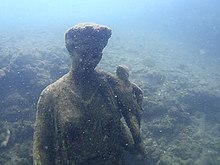
The Marine Protected Areas of Italy restrict human activity for a conservation purpose, to protect natural resources or archaeological sites. There were twenty-seven such marine protected areas, and a further two "Submerged Archaeological Parks" (Italian: parchi sommersi); in 2018, two new marine protected areas were created. these areas help safeguard in total some 228,000 hectares (2,280 km2) of the seas around Italy as well as some 700 kilometres (430 mi) of its coastline, corresponding to 12% of the Italian coasts.[100]
Underwater tourism, both of a naturalistic type and linked to underwater archaeology, is also present.[101] For the naturalistic underwater type, noteworthy seaside locations include the Portofino Marine Protected Area (located between the municipalities of Camogli, Portofino and Santa Margherita Ligure), the island of Giglio, the island of Capraia, and the Maddalena archipelago.[101]
For the underwater archeology type, noteworthy seaside locations include Taormina, Capo Passero, Ustica, Noto, Marettimo, Marzamemi, Santa Maria di Castellabate, Baiae, Gaiola, Ischia, Campi Flegrei, Pantelleria, Syracuse, Gnatia, Isole Tremiti, Manduria and Isola di Capo Rizzuto.[101][102]
Notable Italian lakes that attract underwater tourism, both archaeological and naturalistic type, are Lake Iseo, Lake Como, Lake Garda, Lake Maggiore, Lake Idro, Lago di Levico, Lago di Lases, Lago di Tovel, Lago di Caldonazzo, Lago Grande and Lake of Capodacqua.[103][104][105][106][107]
Shopping tourism
Italy is also a destination for shopping tourism.[108] Italian fashion has a long tradition. The shops that attract the most tourists are those of clothing, leather goods and cosmetics and perfumery, while the most visited Italian cities for this type of tourism are, in descending order of visits, Milan, Florence, Rome, Venice and Turin.[109]
In Milan the most important shopping streets are Via Montenapoleone, Via della Spiga, Via Manzoni, Corso Venezia, Via Sant'Andrea, Corso Vittorio Emanuele, Corso Buenos Aires, Corso di Porta Ticinese, Via Torino and Corso XXII Marzo,[110] while in Florence they are Via de' Tornabuoni, Via dei Calzaiuoli, Via del Corso, Mercato di San Lorenzo and Via Santo Spirito.[111]
In Rome the most important shopping streets are Via Condotti, Via Borgognona, Via Frattina, Via del Corso, Via del Campo Marzio, Via del Pellegrino, Via del Boschetto, Via Cola di Rienzo, Via del Governo Vecchio, Viale Guglielmo Marconi, Via Appia Nuova and Via Tuscolana,[112] while in Venice they are Le Mercerie, Piazza San Marco, Campo San Paolo, Burano and Murano.[113]
In Turin the most important shopping streets are Via Garibaldi, Contrada dei Guardinfanti, Galleria Subalpina, Via Roma, Piazza San Carlo, Piazza Carignano, Via Cesare Battisti, Piazza Carlo Alberto, Piazza Bodoni, Via Mazzini, Via Lagrange, Via Carlo Alberto, Piazza Carlo Felice, Via Po and Piazza Vittorio.[114]
Shopping tourism in Italy is also aimed at outlet stores. The outlets that attract the most tourists are located in Serravalle Scrivia, Castel San Pietro Romano, Barberino di Mugello, Noventa di Piave and Marcianise.[115]
Spa tourism
Italy has one of the largest number of spas in the world,[116] and are appreciated internationally for the quality and effectiveness of the services and treatments offered.[117] This is also due to secondary volcanic phenomena that give rise to the emission of water, vapours and mud enriched by substances present in the Italian subsoil.[118]
Its origins are very remote, it is known that the ancient Greeks had already discovered its healing properties,[119] but the greatest admirers of antiquity were undoubtedly the ancient Romans who made it an aspect of their social life.[120]
The most renowned Italian spas are located in the localities of Abano Terme, Cortina d'Ampezzo, Bibione, Chianciano Terme, Montepulciano, Saturnia, Montecatini Terme, Contursi Terme, Castellammare di Stabia, Bagni San Filippo, Sirmione, Bormio, Viterbo, Pantelleria, Vulcano, Montegrotto Terme, Pescantina, Salsomaggiore Terme and Ischia.[121][122]
Religious tourism
There are numerous pilgrimage destinations in Italy, first of all Rome, the residence of the Pope (who is its bishop) and the seat of the Catholic Church. The city is a pilgrimage destination especially during the main events of Catholic religious life, especially during the Jubilees. Although his figure is not officially recognized by the faithful of other Christian denominations, the presence of the Pope in Rome also attracts others and is an important figure within the Christian creed.[123]
The Seven Pilgrim Churches of Rome are Basilica of St. John Lateran (Major Papal archbasilica), St. Peter's Basilica (Major Papal basilica), Basilica of Saint Paul Outside the Walls (Major Papal basilica), Basilica of St. Mary Major (Major Papal basilica), Basilica of Saint Lawrence outside the Walls (Minor Papal basilica), Basilica of the Holy Cross in Jerusalem (Minor basilica), Sanctuary of Our Lady of Divine Love (Shrine)[124].[125] In addition to the Holy See, there are numerous pilgrimage sites given by the presence of relics and remains of important figures linked to Christianity, rather than by the memory of events that have occurred that the faithful consider miraculous.[126]
Notable churches that are a destination for pilgrimages, in addition to St. Peter's Basilica in Rome, include Sanctuary of Saint Pio of Pietrelcina in San Giovanni Rotondo, Basilica of Saint Francis of Assisi, Basilica della Santa Casa in Loreto, Shrine of the Virgin of the Rosary of Pompei, Basilica of Saint Anthony of Padua, Basilica santuario Madonna delle Lacrime in Syracuse, Church of St. Mary of Mount Berico in Vicenza, Basilica of San Vitale in Ravenna, Basilica of Sant'Apollinare Nuovo in Ravenna and Sanctuary of the Madonna of San Luca in Bologna.[127]
The Via Francigena is an ancient road and pilgrimage route running from the cathedral city of Canterbury in England, through France and Switzerland, to Rome[128] and then to Apulia, Italy, where there were ports of embarkation for the Holy Land.[129] In medieval times it was an important road and pilgrimage route for those wishing to visit the Holy See and the tombs of the apostles Peter and Paul. Today the Via Francigena is travelled by pilgrims especially in the last stretch of the road, the one in Italian territory.[127] Along the Via Francigena there are numerous places of worship such as sanctuaries, convents and churches that attract pilgrims and tourists also for their artistic and architectural beauties.[127]
The Cammino Celeste ("Celestial Way") is also very popular with pilgrims.[127] It is a network of pilgrimage routes that connects the places of worship of Aquileia in Italy, Maria Saal in Austria and Brezje in Slovenia with the Sanctuary of Monte Lussari, located in the Julian Alps in the Italian municipality of Tarvisio, made official as an international pilgrimage route in the summer of 2006.[130] Its name derives from the union of the numerous places of ancient Marian devotion it passed through.[131]
Naturalistic tourism
In Italy, there are several protected areas of various types: natural, mountain or marine parks, regional or local parks, natural, wildlife or zoological reserves. In addition to this, there are numerous natural sites not necessarily protected by a park.
The parks of Italy include areas of land, sea, rivers and their banks, lakes and their environs which have environmental or naturalistic importance and are often valued for their landscape features and for representing particular local traditions. National parks of Italy cover about 5% of the country,[132] while the total area protected by national parks, regional parks of Italy and nature reserves covers about 10.5% of the Italian territory,[133] to which must be added 12% of coasts protected by Marine Protected Areas of Italy.[100]
Italy has one the highest level of faunal biodiversity in Europe, with over 57,000 species recorded, representing more than a third of all European fauna.[134] The fauna of Italy includes 4,777 endemic animal species,[135] which include the Sardinian long-eared bat, Sardinian red deer, spectacled salamander, brown cave salamander, Italian newt, Italian frog, Apennine yellow-bellied toad, Italian wall lizard, Aeolian wall lizard, Sicilian wall lizard, Italian Aesculapian snake, and Sicilian pond turtle. In Italy there are 119 mammals species,[136] 550 bird species,[137] 69 reptile species,[138] 39 amphibian species,[139] 623 fish species[140] and 56,213 invertebrate species, of which 37,303 insect species.[141]
The flora of Italy was traditionally estimated to comprise about 5,500 vascular plant species.[142] However, as of 2005[update], 6,759 species are recorded in the Data bank of Italian vascular flora.[143] Italy has 1,371 endemic plant species and subspecies,[144] which include Sicilian Fir, Barbaricina columbine, Sea marigold, Lavender cotton and Ucriana violet.
Italy has many botanical gardens and historic gardens, some of which are known outside the country.[145][146] The Italian garden is stylistically based on symmetry, axial geometry and on the principle of imposing order over nature. It influenced the history of gardening, especially French gardens and English gardens.[147] The Italian garden was influenced by Roman gardens and Italian Renaissance gardens.
The Italian caves attract around 1.5 million tourists every year.[148] Main concentration of Italian caves is close to the Alps and the Apennins, principally due to karst.[149] Notable Italian caves are Castellana Caves, Frasassi Caves, Pertosa Cave, Giant Cave, Castelcivita Cave, Toirano Caves, Pastena Caves, Borgio Verezzi Caves, Grotto Calgeron, Grotta del Cavallone, Ear of Dionysius, Grotta del Gelo, Grotta di Ispinigoli, Paglicci Cave, Grotta dell'Addaura, Arene Candide, Castelcivita Caves, Fumane Cave, Neptune's Grotto, Nereo Cave, Pertosa Caves, Grotta dello Smeraldo and Blue Grotto.
Business tourism
Business tourism enlivens entrances to the country and constitutes a fundamental part of the sector. This type includes those who use the accommodation facilities for business trips or to participate in events related to the production or marketing of various goods developed within the most disparate economic sectors. By way of example, the following are reported:
- the Fiera Milano is a trade fair and exhibition organiser headquartered in Milan. The firm is the most important trade fair organiser in Italy and one of the largest in the world.[150]
- the Milan Motorcycle Show, one of the most important exhibitions in the world dedicated to motorcycles.[151]
- the Venice Film Festival is the oldest film festival in the world and one of the "Big Three" alongside Cannes and Berlin.[152][153]
- the Milan Furniture Fair is the most important showcase for the interiors and furnishings of the world.[154]
- the Milan Fashion Week, held twice a year, is one of the most import worldwide[155]
- the Genoa International Boat Show, one of the world's premier boat shows, held every year towards the end of September.[156]
- the Euroflora, held in Genoa every five years, is the most important floral festival in Europe.[157]
- the Terra Madre Salone del Gusto in Turin is an international gastronomy exhibition held every two years.
- the Turin International Book Fair is one of the largest book fairs in Europe.[158][159]
- the Lucca Comics & Games is an annual comic book and gaming convention in Lucca, the most important exhibition in Europe and second in the world after the Comiket in Tokyo.[160][161]
- the Vinitaly is an international wine competition and exposition that is held annually in April in Verona. VinItaly has been called the "most important convention of domestic and international wines"[162] and the "largest wine show in the world".[163][164]
- the Bologna Children's Book Fair is the leading professional fair for children's books in the world.[165] It is held yearly for four days in March or April in Bologna
- the Milano Monza Open-Air Motor Show is an annual auto show held in June 2021 in Milan and Monza, Italy.[166][167][168]
- the Concorso d'Eleganza Villa d'Este is a Concours d'Elegance event in Italy for classic and vintage cars. It takes place annually near the Villa d'Este hotel in Cernobbio, on the western shore of Lake Como. Since 2011, the event has taken place in the second half of May.
- the Genoa Science Festival is an annual science festival held in Genoa since 2003.[169] In 2006, the year in which it had 250,000 visits,[170] the Genoa Science Festival has been selected, the only Italian initiative, among the ten best events selected in 31 countries in the field of the promotion of culture scientific and technological at European level.[171]
- the Pitti Immagine is a collection of fashion industry events in Italy.[172] Pitti Immagine, is one of the world's most important platforms for men's clothing and accessory collections, and for launching new projects in men's fashion. It's held twice yearly in Florence, at the Fortezza da Basso.[173] The first edition of Pitti Immagine was held in Florence in September 1972.[174]
- the EuroChocolate is an annual chocolate festival that takes place in Perugia, the capital of the Umbria region in central Italy.[175] The festival has been held since 1993, and is one of the largest chocolate festivals in Europe.[176]
- the Giffoni Film Festival is one of the most well-known children's film festivals in the world.[177] It takes place in a small Italian town of Giffoni Valle Piana in Campania, close to Salerno and Naples. The Giffoni Film Festival has had a great impact in the history of entertainment and culture, not only in Italy, and it has developed a high reputation internationally.[178]
Food and wine tourism
Italian cuisine is one of the best known and most appreciated gastronomies worldwide.[179] Italian cuisine includes deeply rooted traditions common to the whole country, as well as all the regional gastronomies, different from each other, especially between the north and the south of Italy, which are in continuous exchange.[180][181][182] Many dishes that were once regional have proliferated with variations throughout the country.[183][184] Italian cuisine offers an abundance of taste, and is one of the most popular and copied around the world.[185] Italy is the world's largest producer of wine, as well as the country with the widest variety of indigenous grapevine varieties in the world.[186][187]
One of the main characteristics of Italian cuisine is its simplicity, with many dishes made up of few ingredients, and therefore Italian cooks often rely on the quality of the ingredients, rather than the complexity of preparation.[188][189] The most popular dishes and recipes, over the centuries, have often been created by ordinary people more so than by chefs, which is why many Italian recipes are suitable for home and daily cooking, respecting regional specificities, privileging only raw materials and ingredients from the region of origin of the dish and preserving its seasonality.[190][191][192]
Italian meal structure is typical of the European Mediterranean region and differs from North, Central, and Eastern European meal structure, though it still often consists of breakfast (colazione), lunch (pranzo), and supper (cena).[193] However, much less emphasis is placed on breakfast, and breakfast itself is often skipped or involves lighter meal portions than are seen in non-Mediterranean Western countries.[194] Late-morning and mid-afternoon snacks, called merenda (plural merende), are also often included in this meal structure.[195]
The Mediterranean diet forms the basis of Italian cuisine, rich in pasta, fish, fruits and vegetables.[196] Cheese, cold cuts and wine are central to Italian cuisine, and along with pizza and coffee (especially espresso) form part of Italian gastronomic culture.[197] Desserts have a long tradition of merging local flavours such as citrus fruits, pistachio and almonds with sweet cheeses like mascarpone and ricotta or exotic tastes as cocoa, vanilla and cinnamon. Gelato,[198] tiramisù[199] and cassata are among the most famous examples of Italian desserts, cakes and patisserie.
Italian cuisine relies heavily on traditional products; the country has a large number of traditional specialities protected under EU law.[200] From the 1950s onwards, a great variety of typical products of Italian cuisine have been recognized as PDO, PGI, TSG and GI by the Council of the European Union, to which they are added to the Indicazione geografica tipica (IGT), the regional Prodotto agroalimentare tradizionale (PAT) and the municipal Denominazione comunale d'origine (De.C.O.).[201][202] In the oenological field, there are specific legal protections: the Denominazione di origine controllata (DOC) and the Denominazione di origine controllata e garantita (DOCG).[203] Protected designation of origin (PDO) and Protected Geographical Indications (PGI) have also been established in olive growing.[204]
The cuisine is therefore often a reason for tourism in the peninsula, perhaps combined with one or more reasons previously described.[205] There are countless food festivals and fairs spread throughout the area, from small agricultural centres to large metropolises.[206] The hospitality sector is slowly updating by including cultural food and wine elements in its offer to tourists, both in traditional hotels and in specially created structures such as agritourisms.[207] In 2018 the food and wine expenditure by foreign tourists amounted to 9.23 billion euros, with an average expenditure of 117 euros each.[208]
Sports tourism


Sport in Italy has a long tradition. In several sports, both individual and team, Italy has good representation and many successes. Football is the most popular sport in Italy.[209] Italy won the 2006 FIFA World Cup, and is (along with Germany) currently the second most successful football team in World Cup history, after Brazil, having won four FIFA World Cup championships. Basketball, volleyball, and cycling are the next most popular/played sports, with Italy having a rich tradition in all three. Italy also has strong traditions in swimming, water polo, rugby union, tennis, athletics, fencing, and Formula One.
Tourism linked to sporting events is capable of attracting fans of various disciplines who, in several cases, then decide to stay to visit the country.[210] In addition to events of a global nature, capable of attracting a large number of visitors for a longer period of time (for example the 2006 Turin Winter Olympics or the 1990 FIFA World Cup), minor events also contribute to the development of this factor of tourism, such as individual international matches of various sports (for example the home matches of Italy during the Six Nations Championship or the matches of clubs of various sports involved in continental competitions) or tournaments of more local importance.[211]
The Serie A is a professional league competition for football clubs located at the top of the Italian football league system and the winner is awarded the Scudetto and the Coppa Campioni d'Italia. Serie A is regarded as one of the best football leagues in the world and it is often depicted as the most tactical and defensively sound national league.[212] Serie A was the world's strongest national league in 2020 according to IFFHS,[213] and is ranked third among European leagues according to UEFA's league coefficient, behind La Liga and the Premier League and ahead of the Bundesliga and Ligue 1, which is based on the performance of Italian clubs in the Champions League and the Europa League during the previous five years. Serie A led the UEFA ranking from 1986 to 1988 and from 1990 to 1999.[214]
The Italian Grand Prix is the fifth oldest national Grand Prix (after the French Grand Prix, the American Grand Prize, the Spanish Grand Prix and the Russian Grand Prix), having been held since 1921. In 2013 it became the most held Grand Prix (the 2021 edition was the 91st). It is one of the two Grands Prix (along with the British) which has run as an event of the Formula One World Championship Grands Prix every season, continuously since the championship was introduced in 1950. Every Formula One Italian Grand Prix in the World Championship era has been held at Monza except in 1980, when it was held at Imola.
The Giro d'Italia is an annual multiple-stage bicycle race primarily held in Italy, while also starting in, or passing through, other countries.[215] The first race was organized in 1909 to increase sales of the newspaper La Gazzetta dello Sport;[215][216] and is still run by a subsidiary of that paper's owner.[217][218] The Giro is a UCI World Tour event, which means that the teams that compete in the race are mostly UCI WorldTeams, with some additional teams invited as 'wild cards'.[219][220] Starting in 1909, the Giro d'Italia is the Grands Tours' second oldest.[221]
The Mille Miglia was an open-road, motorsport endurance race established in 1927 by the young Counts Francesco Mazzotti and Aymo Maggi, which took place in Italy twenty-four times from 1927 to 1957 (thirteen before World War II, eleven from 1947).[222] From 1953 until 1957, the Mille Miglia was also a round of the World Sports Car Championship. Since 1977, the "Mille Miglia" has been reborn as a regularity race for classic and vintage cars. Participation is limited to cars, produced no later than 1957, which had attended (or were registered to) the original race. The route (Brescia–Rome round trip) is similar to that of the original race, maintaining the point of departure/arrival in Viale Venezia in Brescia.
Historical traditions tourism
Traditions of Italy are some set of traditions, beliefs, values, and customs that belongs within the culture of Italian people. These traditions have influenced life in Italy for centuries, and are still practiced in our modern days.
Notable traditional Italian events that attract tourists are the celebrations of the Epiphany in Rome, the Festival of Saint Agatha of Catania, the Carnival of Venice, the Scoppio del carro in Florence, the Fish Festival of Camogli, the Infiorate di Spello, the Festival of Saint Rosalia of Palermo, the Notte della Taranta of Salento, the Chilli Festival of Diamante, the Grape Festival of Marino, the Christmas markets of Trentino-Alto Adige, the Nativity play of Sassi di Matera, the Battle of the Oranges of Ivrea, Almond Blossom Festival of Agrigento, Tulip Festival of Castiglione del Lago, May Day of Assisi, Festival of the Knot of Love of Valeggio sul Mincio, Medieval Festivals of Brisighella, Prosciutto di San Daniele Festival of San Daniele del Friuli, Festa del Redentore of Venice, Macchina di Santa Rosa of Viterbo, Rice Fair of Isola della Scala, Barcolana regatta of Trieste and Nougat Festival of Cremona.[223][224]
Traditional sports also attract tourists in Italy, such as the Palio, the name given in the country to an annual athletic contest, very often of a historical character, pitting the neighbourhoods of a town or the hamlets of a comune against each other. Typically, they are fought in costume and commemorate some event or tradition of the Middle Ages and thus often involve horse racing, archery, jousting, crossbow shooting, and similar medieval sports.[225] The Palio di Siena is the only one that has been run without interruption since it started in the 1630s and is definitely the most famous all over the world,[226] attracting tourists from every continent.[227]
Another traditional Italian sport that attracts tourists is the Calcio Fiorentino (also referred to as calcio storico, "historic football"), an early form of football (soccer and rugby) that originated during the Middle Ages and is still played annually today in the Piazza Santa Croce in Florence.[228][229] Other important Italian traditional competitions that attract tourists are the Palio di Asti, the Palio di Legnano, the Palio di Ferrara, the Giostra del Saracino and the Giostra della Quintana.[230]
UNESCO World Heritage Sites tourism
Italy is the country with the highest concentration in the world of the UNESCO World Heritage Sites.[231][12] As of 2021[update], Italy has a total of 58 inscribed sites, making it the country with the most World Heritage Sites just above China (56).[231][12] Out of Italy's 58 heritage sites, 53 are cultural and 5 are natural.[12] 50% of the tourists who visit the UNESCO heritage sites in Italy are foreigners, and of these, 75% are in Italy for a cultural holiday.[232]
Among the most famous Italian UNESCO World Heritage Sites there are Sassi di Matera; Porto Venere, Palmaria, Tino, Tinetto and Cinque Terre; Val d'Orcia; Early Christian Monuments of Ravenna; Valle dei Templi; Alberobello; Etruscan Necropolises of Cerveteri and Tarquinia; Pompeii, Torre Annunziata and Herculaneum; Palmanova; Barumini nuraghes; Dolomites; Santa Maria delle Grazie and The Last Supper; Castel del Monte; Royal Palace of Caserta, Aqueduct of Vanvitelli and San Leucio Complex; Syracuse and Necropolis of Pantalica; Villa d'Este; Langhe-Roero and Montferrat; Aeolian Islands; Val di Noto; Amalfi Coast; Rhaetian Railway in the Albula/Bernina Landscapes; Aquileia; Duomo and the Leaning Tower of Pisa; Arab-Norman Palermo and the Cathedral Churches of Cefalù and Monreale; Residences of the Royal House of Savoy; Parco Nazionale del Cilento, Vallo di Diano e Alburni, Paestum, Velia and Certosa di Padula; Scrovegni Chapel.[233][234][235]
Historic villages tourism
The historic Italian villages are attracting an increasing number of tourists.[236] These villages are part of I Borghi più belli d'Italia (English: The most beautiful villages of Italy), an association that includes, as of November 2021, 325 villages[237] and that organizes initiatives within the villages, such as festivals, exhibitions, fetes, conferences and concerts that highlight the cultural, historical, gastronomic and linguistic heritage, involving residents, schools, and local artists.[238] The club promotes numerous initiatives on the international market.[239][240][241][242][243][244] In 2016, the association signed a global agreement with ENIT,[245] to promote tourism in the most beautiful villages in the world.[246] In 2017, the club signed an agreement with Costa Cruises[247] for the enhancement of some villages, which are offered to cruise passengers arriving in Italian ports aboard the operator's ships.[248]
The Bandiera arancione is a tourist-environmental quality recognition conferred by the Touring Club Italiano (TCI) to small towns in the Italian hinterland (maximum 15,000 inhabitants) which stand out for their quality hospitality.[249] The idea was born in 1998 in Sassello (in Liguria), from the need of the regional body to promote and enhance the hinterland.[250] The TCI therefore developed an analysis model (called territorial analysis model or MAT) to identify the first deserving localities.[251] Subsequently, the recognition was promoted on a national scale, identifying small places of excellence in each region.[251] The group, as of June 2021, includes 252 villages.[252] The project is the only Italian one included by the World Tourism Organization among the programs successfully implemented for the sustainable development of tourism worldwide.[253]
Nightlife tourism
The nightlife in Italy is attractive to both tourists and locals. Italy is known to have some of the best nightlife in the world.[254] The best known Italian destinations for nightlife are:[254][255]
- Milan (Lombardy), in particular Navigli, Brera, Isola, Porta Romana, Lambrate, Idroscalo, Corso Como, Corso Sempione and Colonne di San Lorenzo;
- Florence (Tuscany), in particular the neighborhoods of Oltrarno, Santo Spirito and Santa Croce;
- Rome (Lazio), in particular the neighborhoods of Pigneto, San Lorenzo and Ostiense;
- Venice (Veneto), in particular the neighborhoods of Erbaria, Fondamenta Misericordia and Santa Margherita;
- Salento (Apulia), in particular Gallipoli, Otranto and Lecce;
- Riviera of Romagna (Emilia-Romagna), in particular Riccione, Rimini and Milano Marittima;
- Jesolo (Veneto);
- Riviera del Corallo (Sardinia), in particular Alghero;
- Ischia (Campania);
- Coast of the Gods (Calabria), in particular Tropea, Capo Vaticano and Scilla.
LGBT tourism
Italy represented one of the main homosexual male tourist destinations between the end of the 19th century and the beginning of the 20th century.[256] In fact, in Italy there were no anti-homosexual laws, which were widespread in the countries of Northern Europe, such as the German paragraph 175 or the sentences suffered by Oscar Wilde in the United Kingdom.[256] Places such as Capri, Taormina, Florence, Venice, Rome and Naples were the favourite places of homosexual tourism of the time.[256]
This type of tourism disappeared in Italy in the 1950s due to changed political and social conditions, which favoured other types of tourism, such as "family" tourism.[256] As a consequence, other Mediterranean cities (such as Mykonos, Ibiza and Sitges) took the place of the Italian ones for LGBT tourism.[256]
Today LGBT tourism in Italy is mainly an urban phenomenon, such as in Milan and Rome due to the high variety of discos, pubs, bars, cruising, saunas, B&B, restaurants, which meet all needs. of the nightlife.[257][258] In summer, however, the first Italian gay resort is Gallipoli which, with bars, discos, B&B and beaches, attracts people from all over Italy and abroad, taking away the primacy of Versilia.[259] The naturist beaches of Spiaggia D'Ayala, Campomarino di Maruggio, Torre Guaceto and Brindisi attract LGBT crowds from all over the world.[260]
Luxury tourism
Luxury tourism in Italy is highly developed, corresponding to €25 billion (in particular €2 billion for catering and €14 billion for visits, excursions and shopping), a figure that increases, also considering the related activities and the indirect expenses of luxury tourists, to €60 billion, which corresponds to 3% of Italy's GDP.[261]
The companies operating in the luxury tourism sector in Italy are 1% of the accommodation businesses present in the country, corresponding to approximately 3% of the nights spent in Italian accommodation facilities, but generate 25% of the total expenditure of tourists who choose Italy as their destination, and 15% of the total turnover of accommodation facilities.[261] These data can be explained by considering some characteristics of luxury tourism where these tourists who travel to Italy spend nine times more than the average, and the most expensive hotels employ twice as many employees as an average quality hotel.[261]
Regarding luxury tourism, Italy ranks 1st in the world for artistic-cultural tourism and food and wine tourism, 2nd place for mountain tourism and tourism in large cities and 4th place for seaside tourism.[261] As for the most popular destinations for luxury tourists in Italy, in mountain tourism are the Dolomites, especially Cortina d'Ampezzo and Madonna di Campiglio, Trentino-Alto Adige, especially Selva di Val Gardena, and Aosta Valley, in particular Courmayeur, for lake tourism Lake Como and Lake Garda, in particular Gardone Riviera, while for seaside tourism the Cinque Terre and Portofino, the Amalfi Coast, in particular Amalfi, Ravello and Positano, the island of Capri, the Costa Smeralda (especially Porto Cervo), Porto Ercole, Forte dei Marmi, Santa Margherita Ligure and Taormina.[262][263][264] As for the Italian cities, the most visited by luxury tourists are Venice, Milan, Florence and Rome.[262]
In particular, Costa Smeralda is the most expensive location in Europe. House prices reach up to €300,000 ($392,200) per square meter.[265][266][267] Development of the Costa Smeralda started in 1961, and was financed by a consortium of companies led by Prince Karim Aga Khan. Spiaggia del Principe, one of the beaches along the Costa Smeralda, was named after this Ishmaelite prince.[268]
Amusement and theme park tourism
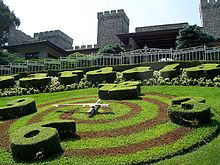
The most visited amusement park in Italy is Gardaland, with 3 million visitors per year (2019).[269]. Located in Castelnuovo del Garda, is adjacent to Lake Garda. The entire complex covers an area of 445,000 m2 (4,789,940 sq ft), while the theme park alone measures 200,000 m2 (2,152,782 sq ft).[269] Gardaland is the eighth in Europe by the number of amusement park visitors (2019).[269] In June 2005 Gardaland ranked fifth in the Forbes ranking of the top ten best amusement parks in the world.[270]
The second most visited Italian amusement park is Mirabilandia, with 2 million annual visitors (2019).[269] Located in Savio, a frazione of Ravenna, with a total area of 850,000 m2 (9,149,324 sq ft) it is the biggest amusement park in Italy.[271] Other popular Italian amusement/theme parks are Cinecittà World in Rome, Zoomarine in Torvaianica, Cavallino Matto in Marina di Castagneto Carducci, Italia in miniatura in Rimini, Cowboyland in Voghera, Pombia Safari Park in Pombia, Aquarium of Genoa, Parco Natura Viva in Bussolengo, Zoom Torino in Cumiana and Le Cornelle in Valbrembo.
Roots tourism
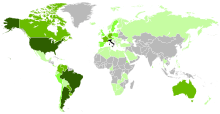
Italy has experienced a conspicuous emigration to foreign countries following Italian unification, World War I and World War II. By 1980, it was estimated that about 25,000,000 Italians were residing outside Italy.[272] It is estimated that the number of their descendants, who are called "oriundi", is about 80 million worldwide.[273]
This includes about 60% of Argentina's population (Italian Argentines),[274][275] 1/3 of Uruguayans (Italian Uruguayans), 15% of Brazilians (Italian Brazilians, the largest Italian community outside Italy),[276] more than 5 million Venezuelans (Italian Venezuelans),[277] and people in other parts of Europe (e.g. Italians in Germany, Italians in France and Italians in the United Kingdom), the Americas (such as Italian Americans, Italian Canadians, Italian Colombians and Italians in Paraguay, among others), Australasia (Italian Australians and Italian New Zealanders), and to a lesser extent in the Middle East.
This phenomenon has led to an important flow of tourists of Italian origin who visit the country and discover their roots.[278] The trip to Italy of these tourists is mainly about knowing the places, the language, the cuisine and the people to which their ancestors belonged.[279] In 2018, about 10 million tourists of Italian origin went to the country to rediscover their roots.[278]
Student programmes tourism
A student exchange program is a program in which students from a secondary school (high school) or university study abroad at one of their institution's partner institutions.[280] Italy is one of the destinations of secondary school students and university students participating in exchange programmes.[281][282] Students who go to study in Italy also take advantage of their stay to visit the country.[283][284]
Italy is one of the main destinations of the Erasmus Programme, fifth in Europe after Spain, Germany, France and the United Kingdom respectively.[285] The Erasmus Programme is a European Union (EU) student exchange programme established in 1987.[286][287] Erasmus+, or Erasmus Plus, is the new programme combining all the EU's current schemes for education, training, youth and sport, which was started in January 2014.
The first five Italian universities that have hosted the largest number of students of the Erasmus Programme are, respectively, the University of Bologna, the Sapienza University of Rome, the University of Florence, the Polytechnic University of Milan and the University of Padua.[288] In particular, the University of Bologna, founded in 1088, is the oldest university in continuous operation in the world, and the first university in the sense of a higher-learning and degree-awarding institute, as the word universitas was coined at its foundation.[289][290][291][292] Also, University of Padua, founded in 1222, and University of Naples Federico II, founded in 1224, are the oldest universities in Europe.[293][294] 33 Italian universities were ranked among the world's top 500 in 2019, the third-largest number in Europe after the United Kingdom and Germany.[295]
Regions
Northwest Italy
- Regions: Piedmont, Liguria, Lombardy and Aosta Valley
Home of the Italian Riviera, including Portofino, Sanremo, and of Cinque Terre. There are many historic cities in this part of Italy: Turin, the manufacturing capital of Italy, Milan, the business and fashion capital of the country and the important port of Genoa are the most popular tourist destinations of the area.
Other cities like Aosta, Bergamo, Brescia, Como and Mantua have a rich cultural heritage, which share the region's visitors with beautiful landscapes such as the lakes Garda (with Grottoes of Catullus and Gardone Riviera), Como (with Bellagio and Varenna) and Maggiore (with Borromean Islands and Angera). There are also important ski resorts like Sestriere, Courmayeur, Breuil-Cervinia, Livigno and Bormio.
Northeast Italy
- Regions: Emilia-Romagna, Friuli-Venezia Giulia, Trentino-Alto Adige/Südtirol and Veneto
This part of Italy also boasts several important tourist attractions, such as the canal-filled city of Venice, the cities of Verona, Vicenza, Padua, Trento, Bolzano, Cremona, Bologna, Ferrara, Parma, Ravenna, Cesena, Rimini and Trieste.
There are also several mountain ranges such as the Dolomites, the Carnic and Julian Alps and first-class ski resorts like Cortina d'Ampezzo and Madonna di Campiglio. These four regions offer much to see and do. The area has a unique cuisine, including wines and dishes such as Prosecco and Tiramisu in Veneto and Cotechino, Ragu and Parma ham in Emilia Romagna, San Daniele ham and D.O.C. wines in Valpolicella, Lake Garda, Valdobbiadene, Trentino and Friuli-Venezia Giulia.
Central Italy
This area is possibly the most visited in Italy and contains many popular attractions as well as sought-after landscapes. Rome boasts the remaining wonders of the Roman Empire and some of the world's best known landmarks such as the Colosseum.
Florence, regarded as the birthplace of the Italian Renaissance, is Tuscany's most visited city, whereas nearby cities like Siena, Pisa, Arezzo and Lucca also have rich cultural heritage. Umbria's population is small but it has many important cities such as Perugia and Assisi. For similar reasons, Lazio and Tuscany are some of Italy's most visited regions and the main targets for Ecotourism.
This area is known for its picturesque landscapes and attracts tourists from all over the world, including Italy itself. Pristine landscapes serve as one of the primary motivators for tourists to visit central Italy, although there are others, such as a rich history of art.
Southern Italy
Southern Italy (also called Mezzogiorno) is well known for the cuisine, that offers a wide choice of food at lower prices. It is also known for the pairing of Mediterranean clime with the beautiful beaches of each region, an important element for local tourism. Naples is the most visited city in the area, and the ruins of Pompeii are the most visited sights.
Other important tourist destinations include the Amalfi Coast, Ravello, Benevento, Caserta, Salerno and Pozzuoli. The natural parks of Abruzzo, the greenest region in Europe,[296] include the Abruzzo National Park, the National Park of Gran Sasso and Monti della Laga the Maiella National Park and Sirente-Velino Regional Park which attract thousands of visitors due to more than 30 protected Nature Reserves and the presence of 75% of all Europe's living species.[297]
Apulia, which includes the historical cities of Lecce and Bari and villages composed of trulli; like Calabria it is famous for its coasts. Basilicata is very famous for so-called Sassi di Matera. The main city of Molise are Campobasso and Isernia, the most important sight is the Basilica of Castelpetroso. Calabria coasts are very appreciated by tourists; the capital city is Catanzaro but its most populated city is Reggio Calabria.
Insular Italy
Sicily, the largest island in the country, is a diverse and popular tourist island, famous for its archaeology, seascape and unique Sicilian cuisine. There are many important cities such as Palermo, Messina, Catania. An important sight is Val di Noto which offers a lot of Late Baroque cities built after the catastrophic earthquake of 1693.
Sardinia is a large island some 250 kilometres west of the Italian coastline. It includes several popular tourist attractions and has several beaches and archaeological ruins. It is also known for its beaches, which are among the most beautiful in the world, and include the famous pink beaches in the archipelago of La Maddalena.
The most popular cities in Sardinia are: Cagliari, Sassari, Alghero, Olbia and Porto Cervo. Porto Cervo, located in Costa Smeralda, is a popular summer destination famous for its beaches and clubs among high-income earners.
Vacation in Italy in ancient times

It was the ancient Romans who invented the concept of "vacation".[298] The vacation was the prerogative of the patricians, the wealthiest social caste, who owned villas outside Rome, mainly in the Latium hinterland and on the Tyrrhenian coast.[299] The most popular place in Roman Italy to vacation was Naples, an important cultural centre and a place that attracted artists, philosophers and scholars of the time.[299]
The ancient Romans also visited Italy to learn about their origins, especially in regards to the history, ancient legends and myths related to the founding of Rome.[298] Among the most popular destinations for this type of vacation were the Circeo, where the jug was kept which, according to tradition, had been used by Odysseus during his stay with the sorceress Circe.[298] Another destination was a visit to the ship with which, according to tradition, Aeneas, a hero destined by fate to the founding of Rome, had arrived on the shores of Latium.[298]
At the height of the imperial era, the city of Rome became a destination for aristocrats from all over the Roman province who visited the capital to admire its most important monuments such as the Colosseum, the Ara Pacis, the Pantheon and the Trajan's Column.[298] However, the vacation resorts were numerous, from the lakes of Northern Italy to Sicily. The most visited by the ancient Romans were the Phlegraean Fields, Pozzuoli, the hill of Posillipo, Baiae, Cape Miseno and the island of Capri.[298]
In particular in Baiae, which was characterized by a favourable climate all year round, there were natural springs of sulphurous hot water with healing properties.[298] The city then became a famous seaside resort, embellished by the presence of spas and luxurious villas.[298] Here Julius Caesar, Pompey, Marcus Licinius Crassus, Cicero, Seneca the Younger, Caligula and Nero owned a villa for vacationing.[298] Other important vacation localities of the ancient Romans were Pompeii and Herculaneum, which were destroyed by the eruption of Mount Vesuvius in 79 AD.[298]
Cities
Rome
Rome is the capital city of Italy. It is also the capital of the Lazio region, the centre of the Metropolitan City of Rome, and a special comune named Comune di Roma Capitale. Rome is the country's most populated comune and the third most populous city in the European Union by population within city limits. Rome is located in the central-western portion of the Italian Peninsula, within Lazio (Latium), along the shores of the Tiber. Vatican City (the smallest country in the world)[300] is an independent country inside the city boundaries of Rome, the only existing example of a country within a city; for this reason, Rome has sometimes been described as the capital of two states.[301][302]
Rome is often referred to as the City of Seven Hills due to its geographic location, and also as the "Eternal City".[303] Rome is generally considered to be the "cradle of Western Christian culture and civilization", and the center of the Catholic Church.[304][305][306] Rome's history spans 28 centuries. While Roman mythology dates the founding of Rome at around 753 BC, the site has been inhabited for much longer, making it a major human settlement for almost three millennia and one of the oldest continuously occupied cities in Europe.[307] The city's early population originated from a mix of Latins, Etruscans, and Sabines. Eventually, the city successively became the capital of the Roman Kingdom, the Roman Republic and the Roman Empire, and is regarded by many as the first-ever Imperial city and metropolis.[308] It was first called The Eternal City (Latin: Urbs Aeterna; Italian: La Città Eterna) by the Roman poet Tibullus in the 1st century BC, and the expression was also taken up by Ovid, Virgil, and Livy.[309][310] Rome is also called "Caput Mundi" (Capital of the World).
Rome has become increasingly popular as a tourist destination globally. 45.6% from 2006 (6.03 million), Rome hosted 8.78 million international tourists in 2014, placing itself as the 14th most visited city in the world.[311] Popular tourists attractions in the city include the Colosseum, St Peter's Basilica, the Pantheon and so on, all of which are part of the World Heritage property.[312] Other main sights in the city include, the Trevi Fountain, Piazza Navona, Roman Forum,[313] Castel Sant'Angelo, the Basilica of St. John Lateran,[314] the Spanish Steps, Villa Borghese park, Piazza del Popolo, the Trastevere and the Janiculum.[315]
Milan
Milan is a city in northern Italy, capital of Lombardy, and the second-most populous city proper in Italy after Rome. Milan is considered a leading alpha global city,[316] with strengths in the fields of art, commerce, design, education, entertainment, fashion, finance, healthcare, media, services, research and tourism. Its business district hosts Italy's stock exchange (Italian: Borsa Italiana), and the headquarters of national and international banks and companies. In terms of GDP, Milan is the wealthiest city in Italy, it has the third-largest economy among EU cities after Paris and Madrid, and is the wealthiest among EU non-capital cities.[317][318][319] Milan is viewed along with Turin as the southernmost part of the Blue Banana urban development corridor (also known as the "European Megalopolis"), and one of the Four Motors for Europe.
Milan is one of Europe's most important tourist destinations, and Italy's second; with 6.05 million international arrivals as measured in 2014, it placed itself as the 24th most visited city in the world.[311] According to a particular source, 56% of international visitors to Milan are from Europe, whilst 44% of the city's tourists are Italian, and 56% are from abroad.[320] The most important European Union markets are the United Kingdom (16%), Germany (9%) and France (6%).[320] According to the same study, most of the visitors who come from the USA to the city go on business matters, whilst Chinese and Japanese tourists mainly take up the leisure segment.[321]
The city boasts several popular tourist attractions, such as the city's Duomo and Piazza, the Teatro alla Scala, the San Siro Stadium, the Vittorio Emanuele II Gallery, the Sforza Castle, the Pinacoteca di Brera and the Via Monte Napoleone. Most tourists visit sights such as Milan Cathedral, the Sforza Castle and the Teatro alla Scala, however, other main sights such as the Basilica of Sant'Ambrogio, the Navigli and the Brera district are less visited and prove to be less popular.[321]
The city also has numerous hotels, including the ultra-luxurious Town House Galleria, which is the world's first seven-star hotel, ranked officially by the Société Générale de Surveillance, and one of The Leading Hotels of the World.[322] The average stay for a tourist in the city is of 3.43 nights, whilst foreigners stay for longer periods of time, 77% of which stay for a 2-5 night average.[321] Of the 75% of visitors which stay in hotels, 4-star ones are the most popular (47%), whilst 5-stars, or less than 3-stars represent 11% and 15% of the charts respectively.
Naples
Naples is the regional capital of Campania and the third-largest city of Italy, after Rome and Milan. Founded by Greeks in the first millennium BC, Naples is one of the oldest continuously inhabited urban areas in the world.[323] In the ninth century BC, a colony known as Parthenope (Ancient Greek: Παρθενόπη) was established on the Island of Megaride.[324] In the 6th century BC, it was refounded as Neápolis.[325] The city was an important part of Magna Graecia, played a major role in the merging of Greek and Roman society, and was a significant cultural centre under the Romans.[326]
Its historic city centre is the largest in Europe and is listed as a UNESCO World Heritage Site.[327] Naples is also near the famous volcano Vesuvius and the ruins of the ancient Roman towns of Pompeii and Ercolano. Before italian unification it was the capital of Kingdom of the Two Sicilies and the most important and populated city of Italy. Naples is well known for cuisine, especially for pizza. In the city there are many tourist attractions, such as the Royal Palace, the basilica of Santa Chiara, the Gesù Nuovo (New Jesus) church, Castel dell'Ovo, the Castel Nuovo, the Castel Sant'Elmo, the city's Duomo, the Real Teatro di San Carlo (the oldest continuously active opera house in the world), the Palace of Capodimonte, the Naples underground geothermal tunnels, the Via Tribunali, Spaccanapoli street, the Veiled Christ (one of the world's most remarkable sculptures), the various catacombs around the city (for example the Catacombs of San Gennaro, or the Fontanelle cemetery, or the Catacombs of Saint Gaudiosus), the Umberto I Gallery and the Via Toledo with its metro considered one of the most beautiful of Europe.[328][329]
The Archaeological Museum of Naples is the most important in the world regarding Roman history, and also includes Egyptian and Greek finds. It is the home of the Federico II, the oldest public and secular university in the world, and of the L'Orientale, the oldest school of Sinology and Oriental Studies in Europe. Naples also boasts one of the most picturesque waterfront promenades, and charming locations at Gaiola Island and Marechiaro. Close to Naples, there is a myriad of world-renowned tourist attractions such as the Amalfi Coast, Capri island, Ischia island, Procida island, the picturesque city of Sorrento, and the city of Salerno.
Florence
Florence is a city in Central-Northern Italy and the capital city of the Tuscany region. It is the most populated city in Tuscany, with 383,084 inhabitants in 2013, and over 1,520,000 in its metropolitan area.[330]
Florence was a centre of medieval European trade and finance and one of the wealthiest cities of that era.[331] It is considered by many academics[332] to have been the birthplace of the Renaissance, becoming a major artistic, cultural, commercial, political, economic and financial center.[333] During this time, Florence rose to a position of enormous influence in Italy, Europe, and beyond.[334] Its turbulent political history includes periods of rule by the powerful Medici family and numerous religious and republican revolutions.[335] From 1865 to 1871 the city served as the capital of the Kingdom of Italy (established in 1861). The Florentine dialect forms the base of Standard Italian and it became the language of culture throughout Italy[336] due to the prestige of the masterpieces by Dante Alighieri, Petrarch, Giovanni Boccaccio, Niccolò Machiavelli and Francesco Guicciardini.
The city attracts millions of tourists each year, and UNESCO declared the Historic Centre of Florence a World Heritage Site in 1982. The city is noted for its culture, Renaissance art and architecture and monuments.[337] The city also contains numerous museums and art galleries, such as the Uffizi Gallery and the Palazzo Pitti, and still exerts an influence in the fields of art, culture and politics.[338] Due to Florence's artistic and architectural heritage, Forbes has ranked it as the most beautiful city in the world.[339]
Florence plays an important role in Italian fashion,[338] and is ranked in the top 15 fashion capitals of the world by Global Language Monitor;[340] furthermore, it is a major national economic centre,[338] as well as a tourist and industrial hub. It is the 4th richest Italian city.[341]
Venice
Venice is a city in northeastern Italy and the capital of the Veneto region. It is built on a group of 118 small islands[342] that are separated by canals and linked by over 400 bridges.[342][343] The islands are in the shallow Venetian Lagoon, an enclosed bay lying between the mouths of the Po and the Piave rivers (more exactly between the Brenta and the Sile). In 2020, 258,685 people resided in the Comune di Venezia, of whom around 55,000 live in the historical city of Venice (centro storico). Together with Padua and Treviso, the city is included in the Padua-Treviso-Venice Metropolitan Area (PATREVE), which is considered a statistical metropolitan area, with a total population of 2.6 million.[344]
The name is derived from the ancient Veneti people who inhabited the region by the 10th century BC.[345][346] The city was historically the capital of the Republic of Venice for over a millennium, from 697 to 1797. It was a major financial and maritime power during the Middle Ages and Renaissance, and a staging area for the Crusades and the Battle of Lepanto, as well as an important center of commerce—especially silk, grain, and spice, and of art from the 13th century to the end of the 17th. The city-state of Venice is considered to have been the first real international financial center, emerging in the 9th century and reaching its greatest prominence in the 14th century.[347] This made Venice a wealthy city throughout most of its history.[348] After the Napoleonic Wars and the Congress of Vienna, the Republic was annexed by the Austrian Empire, until it became part of the Kingdom of Italy in 1866, following a referendum held as a result of the Third Italian War of Independence.
Venice has been known as "La Dominante", "La Serenissima", "Queen of the Adriatic", "City of Water", "City of Masks", "City of Bridges", "The Floating City", and "City of Canals". The lagoon and a part of the city are listed as a UNESCO World Heritage Site. Parts of Venice are renowned for the beauty of their settings, their architecture, and artwork.[342] Venice is known for several important artistic movements—especially during the Renaissance period—and has played an important role in the history of instrumental and operatic music, and is the birthplace of Baroque composers Tomaso Albinoni and Antonio Vivaldi.[349]
Although the city is facing some challenges (including an excessive number of tourists and problems caused by pollution, tide peaks and cruise ships sailing too close to buildings),[350][351][352] Venice remains a very popular tourist destination, a major cultural centre, and has been ranked many times the most beautiful city in the world.[1][2] It has been described by the Times Online as one of Europe's most romantic cities[353] and by The New York Times as "undoubtedly the most beautiful city built by man".[354]
Other cities
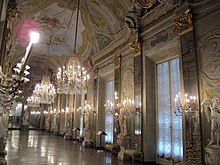
- Palermo—ancient capital of the Kingdom of Sicily and of the Holy Roman Empire under Frederick II. It is noted for its history, gastronomy and architecture; the particularity of the city (such as the rest of Sicily) is that is a meeting point of Greek, Roman, Arabian, Norman and Aragonian cultures.
- Bologna—home of the first university in the western world. This city has a rich history, culture, and technology. Bologna is well known for its cuisine.
- Bari—is well known as a port and university city as well as the city of Saint Nicholas. Capital of Apulia and second most important economic centre of Southern Italy after Naples. The city has a rich culture and history.
- Genoa (Genova)— the Republic of Genoa was one of the most important maritime republics of the Middle Ages. Very wealthy and diverse city. Its port brings in tourism and trade, along with art and architecture. Genoa is the birthplace of Christopher Columbus and the originator of jeans.
- Pisa—the Republic of Pisa was one of the medieval maritime republics, and the city has many medieval palaces and squares. Home to the unmistakable image of the Leaning Tower of Pisa. Very touristy city. Famous too for the Scuola Normale Superiore di Pisa.
- Turin (Torino)—the first capital of Italy, after being the capital of Kingdom of Piedmont-Sardinia, which had promoted national reunification. The city has a rich culture and history. Home of the FIAT, the most important industry in Italy, Turin is a well-known industrial city, based on the aerospace industry and, of course, the automobile industry. Home of the 2006 Winter Olympics.
- Verona—it is one of the main tourist destinations in northern Italy because of its artistic heritage and several annual fairs and shows as well as the opera season in the Arena, an ancient Roman amphitheatre.
- Padua (Padova)—it is picturesque, with a dense network of arcaded streets opening into large communal piazze, and many bridges crossing the various branches of the Bacchiglione, which once surrounded the ancient walls like a moat.
Other popular destinations
Apart from Rome, Milan, Naples, Venice, and Florence are the top destinations for tourism in Italy. Other major tourist locations include Turin, Verona, Bari, Padua, Bologna, Mantua, Messina, Perugia, Palermo, Genoa, Sicily, Sardinia, and Salento.
Two factors in each of these locations are history and geography. The Roman Empire, Middle Ages, Renaissance and the following centuries of the history of Italy have left many cultural artifacts that attract tourists.[13] Winter and summer tourism are present in many locations in the Alps and the Apennines,[8] while seaside tourism is widespread in coastal locations along the Mediterranean Sea.[9]
Italy is home to fiftyeight UNESCO World Heritage Sites, more than any other country, including many entire cities such as Verona, Siena, Vicenza, Ferrara, San Gimignano, Urbino, Matera, Pompei, Noto and Siracusa. Ravenna hosts an unprecedented eight different internationally recognized sites.
Accommodation capacity in Italy
In Italy there is a broad variety of hotels, going from 1-5 stars. According to ISTAT, in 2017, there were 32,988 hotels with 1,133,452 rooms and 2,239,446 beds.[17] As far as extra-hotel facilities (campsites, tourist villages, accommodations for rent, agritourism, etc.) are concerned, in 2017, there are 171,915 with 2,798,352 beds.[17] The tourist flow to coastal resorts is 53 percent; the best equipped cities are Grosseto for farmhouses (217), Vieste for campsites and tourist villages (84) and Cortina d'Ampezzo mountain huts (20).[18][19]
The number of hotels, according to their rating, in 2017, went like this:[355]
- 7-star hotels: 2 (the Town House Galleria located in Milan and Aman Canal Grande in Venice).
- 5-star hotels and 4-star hotels: 6,335 with 859,621 beds.
- 3-star hotels: 18,116 with 1,133,452 beds.
- 2-star hotels and 1-star hotels: 8,537 with 246,373 beds.
See also
Notes
This article includes text copied from http://en.wikivoyage.org/wiki/Italy, an article from Wikivoyage whose text is published under the CC-BY-SA 3.0 licence.
References
- ^ a b "Top 10 most Beautiful Cities in the World 2017". 28 July 2016.
- ^ a b "Top 10 most Beautiful Cities in the World 2018". 2 September 2018.
- ^ "Milan Attractions". The New York Times. Archived from the original on 4 June 2009.
- ^ "The weight of tourism in Italy, the characteristics of the demand and the accommodation capacity" (PDF). 11 December 2018. Event occurs at Bank of Italy.
- ^ UNWTO Tourism Highlights, 2015 Edition. 2015. doi:10.18111/9789284416899. ISBN 9789284416899.
- ^ a b c d "Grand Tour" (in Italian). Retrieved 6 May 2022.
- ^ a b "Italy on the Grand Tour (Getty Exhibitions)". Retrieved 9 June 2015.
- ^ a b "VACANZE IN MONTAGNA IN ITALIA: IN INVERNO E IN ESTATE" (in Italian). Retrieved 1 January 2022.
- ^ a b "Il turismo balneare" (in Italian). Retrieved 1 January 2022.
- ^ "Ranking the 30 Most-Visited Cities in the World". TravelPulse.
- ^ "The World Heritage Convention". UNESCO. Archived from the original on 27 August 2016. Retrieved 1 August 2021.
- ^ a b c d "Italy". UNESCO World Heritage Centre. Archived from the original on 1 December 2021. Retrieved 9 April 2019.
- ^ a b "Viaggiare in Italia: giro turistico" (in Italian). Retrieved 31 December 2021.
- ^ a b "Il museo Italia. Siamo primi al mondo per patrimonio ma sappiamo valorizzarlo?" (in Italian). Retrieved 27 December 2021.
- ^ a b "L'Italia possiede un patrimonio culturale e ambientale unico al mondo" (in Italian). Retrieved 27 December 2021.
- ^ a b c "Crociere, Cemar: 8,8 milioni di passeggeri nei porti italiani" (in Italian). Retrieved 13 May 2022.
- ^ a b c d "Turismo" (PDF) (in Italian). p. 3. Retrieved 2 April 2022.
- ^ a b "Turismo: 91% viaggiatori soddisfatti mete culturali Italia". Repubblica.it. 21 March 2019. Retrieved 26 July 2019.
- ^ a b "Turismo in Italia nel 2018 – Movimento dei clienti e capacità degli esercizi ricettivi" (PDF). istat.it. Retrieved 18 July 2019.
- ^ a b c d e "18th Century Rome and the Grand Tour". Retrieved 9 June 2015.
- ^ Matt Rosenberg. "The History of the Grand Tour of Europe". About.com Education. Retrieved 9 June 2015.
- ^ Hom, Stephanie (2016). Changing Mobilities. London:Routledge. ISBN 9781138778146.
- ^ "Public Transport in Italy". Etias Italy. 30 December 2019. Retrieved 13 December 2021.
- ^ "Italy". Encyclopædia Britannica. Retrieved 9 June 2015.
- ^ "UNITED NATIONS DGACM". www.un.org.
- ^ "San Marino". Encyclopædia Britannica. 2012. Retrieved 1 March 2011.
- ^ "Vatican country profile". BBC News. 2018. Retrieved 24 August 2018.
- ^ "Democracy in Figures". Italian National Institute of Statistics. Archived from the original on 26 January 2021. Retrieved 28 May 2021.
- ^ a b "Principali dimensioni geostatistiche e grado di urbanizzazione del Paese". www.istat.it. 30 October 2014.
- ^ "Clima Italia" (in Italian). Retrieved 30 December 2021.
- ^ "Trasporto aereo in Italia (PDF)". ISTAT. 7 January 2013. Retrieved 5 August 2013.
- ^ Marcus Hernig: Die Renaissance der Seidenstraße (2018) pp 112.
- ^ Bernhard Simon: Can The New Silk Road Compete With The Maritime Silk Road? in The Maritime Executive, 1 January 2020.
- ^ "Vacanze di Natale 2021, dove andare: caccia alle destinazioni meno battute" (in Italian). Retrieved 23 April 2022.
- ^ "Pasqua: città d'arte piene di turisti e prove d'estate sulle spiagge" (in Italian). Retrieved 23 April 2022.
- ^ "Stagionalità" (in Italian). Retrieved 23 April 2022.
- ^ "Turismo, Pasqua-25 aprile boom in Italia: ponte ricchissimo da 5,5 miliardi" (in Italian). Retrieved 23 April 2022.
- ^ "Festa del 2 giugno, il turismo riparte: 9 mln di italiani in viaggio" (in Italian). Retrieved 23 April 2022.
- ^ "Turismo, ponte di Ferragosto verso il tutto esaurito anche nella provincia di Viterbo" (in Italian). Retrieved 23 April 2022.
- ^ "Ponte Ognissanti, 10 milioni di italiani in viaggio: meta preferita sono le città d'arte" (in Italian). Retrieved 23 April 2022.
- ^ "8 dicembre: Assoturismo-CST, l'incertezza frena il turismo, per Ponte Immacolata 4 milioni di pernottamenti ma tante camere vuote" (in Italian). Retrieved 23 April 2022.
- ^ "Annuario statistico italiano 2019" (PDF). Retrieved 7 January 2019.
- ^ a b c "Capacity of collective accommodation establishments and Occupancy in collective accommodation establishments: Movement by type of accommodation, disagregated – provinces". dati.istat.it. Retrieved 30 April 2019.
- ^ "Tourism brochure" (PDF). istat.it. 2018. Retrieved 26 October 2019.
- ^ Italiano, Touring Club. "Il Veneto è la quinta regione più turistica d'Europa". Touring Club Italiano.
- ^ "File:Number of nights spent in tourist accommodation establishments in the top 20 EU-28 tourist regions, by NUTS 2 regions, 2015 (million nights spent) RYB17.png – Statistics Explained". ec.europa.eu.
- ^ "Movimento turistico in Italia nel 2018" (PDF) (in Italian). Retrieved 4 April 2022.
- ^ "La classifica dei 30 musei più visitati in Italia". Retrieved 22 April 2022.
- ^ "I 10 Musei più visitati al Mondo - Classifica Ufficiale". Retrieved 23 April 2022.
- ^ "LE DIECI CHIESE PIU' VISITATE D'ITALIA SECONDO HOLIDU". Retrieved 23 April 2022.
- ^ "Turismo sportivo: tra passione e opportunità" (in Italian). Retrieved 27 December 2021.
- ^ Italy has been described as a "cultural superpower" by Arab news, the Washington Post, The Australian, the Italian consul general in San Francisco Archived 27 November 2015 at the Wayback Machine, the former Foreign Affairs Minister Giulio Terzi and the U.S. President Barack Obama Archived 26 December 2014 at the Wayback Machine.
- ^ Killinger, Charles (2005). Culture and customs of Italy (1. publ. ed.). Westport, Conn.: Greenwood Press. p. 3. ISBN 978-0-313-32489-5.
- ^ Cole, Alison (1995). Virtue and magnificence : art of the Italian Renaissance courts. New York: H.N. Abrams. ISBN 978-0-8109-2733-9.
- ^ Zirpolo, Lilian H. The A to Z of Renaissance Art. Scarecrow Press, 2009. pp. 154-156. Web. 16 July 2012.
- ^ Top Universities Archived 17 January 2009 at the Wayback Machine World University Rankings Retrieved 6 January 2010
- ^ "√ ITALIA: PATRIMONIO MONDIALE DELL'UMANITA'" (in Italian). Retrieved 26 July 2019.
- ^ "CNI UNESCO – Siti Italiani" (in Italian). Archived from the original on 4 May 2016. Retrieved 27 December 2021.
- ^ "Io sono cultura – L'Italia della qualità e della bellezza sfida la crisi – Io sono cultura – L'Italia della qualità e della bellezza sfida la crisi" (in Italian). Archived from the original on 3 March 2016. Retrieved 8 April 2015.
- ^ "Il turismo in Italia: 4,2 milioni di posti di lavoro" (in Italian). Archived from the original on 8 January 2020. Retrieved 8 January 2020.
- ^ Mariangela Tessa. "Turismo: Italia prime nell'Ue per posti di lavoro, impiegate 4,2 milioni di persone" (in Italian). Archived from the original on 7 January 2020.
- ^ "Science and Technology Parks in Italy".
- ^ Cushman-Roisin, Gačić & Poulain 2001, pp. 1–2.
- ^ Limits of Oceans and Seas (PDF) (3rd ed.). Organisation hydrographique internationale. 1953. Archived from the original (PDF) on 8 October 2011. Retrieved 28 December 2020.
- ^ Chisholm, Hugh (ed.). "Tyrrhenian Sea". Encyclopedia Britannica. Cambridge University Press. Retrieved 18 July 2017.
- ^ "Piattaforma Tecnologica Nazionale Marittima". Ministry of Infrastructure and Transport (Italy). Archived from the original on 17 April 2021. Retrieved 28 May 2021.
- ^ a b "Le 25 città costiere più belle d'Italia" (in Italian). Retrieved 27 December 2021.
- ^ Baughan, Rosa (1880). Winter havens in the sunny South, a complete handbook to the Riviera. London: The Bazaar.
- ^ Black, Charles B. (1887). The Riviera, Or The Coast from Marseilles to Leghorn, Including Carrara, Lucca, Pisa, Pistoja and Florence (Third ed.). Edinburgh: Adam and Charles Black.
- ^ "The 22 Most Beautiful Beaches in Europe for 2022". Retrieved 7 June 2022.
- ^ "Vacanze mare Italia" (in Italian). Retrieved 27 December 2021.
- ^ "Crociere: nel 2021 l'Italia con 2,7 milioni di passeggeri torna leader nel Mediterraneo" (in Italian). Retrieved 27 May 2022.
- ^ Antonio Londrillo (2004). Alla scoperta della mia regione (in Italian). Bulgarini. p. 28. ISBN 88-234-2327-9.
- ^ Catherine Richards (2011). Lake Como, Lake Lugano, Lake Maggiore, Lake Garda – The Italian Lakes. Hunter Publishing, Inc. p. 91. ISBN 978-1-58843-770-9.
- ^ "Laghi italiani". Istituto Italiano di Idrobiologia. Archived from the original on 12 October 2006. Retrieved 17 November 2006.
- ^ "Dieci laghi italiani per trascorrere una vacanza attiva all'insegna dello sport" (in Italian). Retrieved 27 February 2022.
- ^ "Quali sono i borghi più belli sui laghi?" (in Italian). Retrieved 26 February 2022.
- ^ "Navigazione laghi" (in Italian). Retrieved 8 May 2022.
- ^ "Navigazione Lago d'Orta" (in Italian). Retrieved 8 May 2022.
- ^ a b "In battello sui laghi lombardi" (in Italian). Retrieved 8 May 2022.
- ^ "Lago d'Orta: cose da vedere, persone da conoscere" (in Italian). Retrieved 8 May 2022.
- ^ "Turismo, i laghi d'Europa più belli da postare su Instagram: tre sono italiani" (in Italian). Retrieved 27 December 2021.
- ^ "Somma - Vesuvio" (in Italian). Retrieved 21 February 2022.
- ^ a b "Superficie territoriale per zona altimetrica" (in Italian). Retrieved 27 December 2021.
- ^ "Sciare in Abruzzo: quali sono le località abruzzesi migliori per la settimana bianca ?" (in Italian). Retrieved 27 December 2021.
- ^ "Vacanze ad alta quota: 5 località di montagna imperdibili" (in Italian). Retrieved 27 February 2022.
- ^ "LE METE DI MONTAGNA PIÙ INCREDIBILI D'ITALIA" (in Italian). Retrieved 27 February 2022.
- ^ "Agriturismo in Montagna in Italia" (in Italian). Retrieved 28 February 2022.
- ^ "Il Grand tour dei vulcani: scoprite i vulcani dell'Italia" (in Italian). Retrieved 10 April 2022.
- ^ "LE COLLINE ITALIANE" (in Italian). Retrieved 28 February 2022.
- ^ "10 DEI BORGHI DI COLLINA PIÙ BELLI D'ITALIA" (in Italian). Retrieved 28 February 2022.
- ^ "L'AMBIENTE COLLINARE ITALIANO" (in Italian). Retrieved 28 February 2022.
- ^ "Vineyard Landscape of Piedmont: Langhe-Roero and Monferrato". World Heritage Centre. UNESCO. Retrieved 29 June 2014.
- ^ "Vineyard Landscape of Piedmont: Langhe-Roero and Monferrato". Association for the Heritage of the Vineyard Landscape of Langhe-Roero and Monferrato. Retrieved 28 November 2014.
- ^ ""Langhe-Roero and Monferrato"".Winetourism.com, Retrieved 12.05.2022
- ^ a b c d e f g h i "I 7 fiumi navigabili in Italia per una vacanza in houseboat" (in Italian). Retrieved 7 May 2002.
- ^ "Visitare i fiumi più belli d'Italia, tra natura e percorsi mozzafiato" (in Italian). Retrieved 7 May 2002.
- ^ "I cercatori d'oro vanno in vacanza" (in Italian). Retrieved 7 May 2002.
- ^ a b c "Avviata la navigazione turistica in Darsena" (in Italian). Retrieved 7 May 2002.
- ^ a b "Le aree protette in Italia" (in Italian). Retrieved 2 March 2022.
- ^ a b c "Il meglio per il turismo subacqueo in Italia" (in Italian). Retrieved 19 January 2022.
- ^ "Un viaggio unico tra bellezze sommerse: l'Italia lancia itinerario europeo nei parchi archeosub del Mediterraneo" (in Italian). Retrieved 19 January 2022.
- ^ "Immersioni Nei Laghi Lombardi" (in Italian). Retrieved 7 June 2022.
- ^ "SPORT ACQUATICI SUI LAGHI LOMBARDI" (in Italian). Retrieved 7 June 2022.
- ^ "Immersione subacquea" (in Italian). Retrieved 7 June 2022.
- ^ "Il Lago Grande di Avigliana e la sua ferrata subacquea. Oltre 2 km di percorsi, dove "il nulla" è abbagliante" (in Italian). Retrieved 7 June 2022.
- ^ "IMMERSIONI NEL LAGO DI CAPO D'ACQUA IN ABRUZZO" (in Italian). Retrieved 7 June 2022.
- ^ "LA MODA ATTRAE I TURISTI VERSO L'ITALIA ANCHE "FUORI STAGIONE"" (in Italian). Retrieved 17 April 2022.
- ^ "Turismo dello shopping: l'Italia in pole position" (in Italian). Retrieved 17 April 2022.
- ^ "Le 10 vie dello shopping di Milano" (in Italian). Retrieved 17 April 2022.
- ^ "Le 5 vie dello shopping a Firenze" (in Italian). Retrieved 17 April 2022.
- ^ "Le 10 vie dello shopping di Roma" (in Italian). Retrieved 17 April 2022.
- ^ "Venezia e lo shopping, le vie migliori della città" (in Italian). Retrieved 17 April 2022.
- ^ "Le vie dello shopping" (in Italian). Retrieved 17 April 2022.
- ^ "Le migliori destinazioni d'Italia per lo shopping tourism" (in Italian). Retrieved 17 April 2022.
- ^ "Il benessere genera il 5,3% del Pil mondiale: e in Italia è boom per Spa e turismo "wellness"" (in Italian). Retrieved 8 January 2022.
- ^ "Spa spettacolari in Italia e in Europa per tutte le stagioni" (in Italian). Retrieved 8 January 2022.
- ^ "IL VULCANESIMO SECONDARIO IN ITALIA" (in Italian). Retrieved 8 January 2022.
- ^ "Le Terme nella Storia" (in Italian). Retrieved 8 January 2022.
- ^ "Viaggio nella storia delle terme romane: dall'antica Roma a oggi" (in Italian). Retrieved 8 January 2022.
- ^ "Turismo termale in Italia, trend in crescita" (in Italian). Retrieved 8 January 2022.
- ^ "Le 10 migliori terme in Italia: le località termali da non perdere" (in Italian). Retrieved 8 January 2022.
- ^ "Summit storico tra i fratelli Papa Francesco e Sua Santità il Patriarca Kirill di Mosca e di tutte le Russie" (in Italian). Retrieved 27 December 2021.
- ^ "Jubilee 2015: visiting the Seven Major Churches of Rome". 5 July 2015. Retrieved 15 September 2016.
- ^ "Churches and Basilicas in Rome". ALL THE INFORMATION ABOUT THE CITY OF ROME. Retrieved 24 December 2021.
- ^ "I santuari e i pellegrinaggi" (in Italian). Retrieved 27 December 2021.
- ^ a b c d "Turismo religioso, in Italia 3 milioni di pellegrini l'anno e 8,6 milioni di presenze" (in Italian). Retrieved 30 March 2022.
- ^ Stanford, Peter (28 March 2021). "Secular pilgrims: why ancient trails still pack a spiritual punch". The Observer.
- ^ Renato Stopani (1992). Centro Studi Romei (ed.). "La via Appia Traiana nel Medioevo" [Via Appia Traiana in the Middle Age] (PDF). Vie Francigene del Sud (in Italian). p. 4.
- ^ "L'Iter Aquileiense - Cammino Celeste" (in Italian). Archived from the original on 13 September 2017. Retrieved 6 July 2017.
- ^ "Antico cammino patriarcale" (in Italian). Retrieved 6 July 2017.
- ^ "National Parks in Italy". Parks.it. 1995–2010. Archived from the original on 29 March 2010. Retrieved 15 March 2010.
- ^ "Regione e aree protette" (in Italian). Retrieved 11 January 2022.
- ^ "Italy's Fifth National Report to the Convention on Biological Diversity" (PDF). Italian Ministry for the Environment, Land and Sea. p. 7. Archived (PDF) from the original on 18 May 2015. Retrieved 17 May 2015.
- ^ "CHECKLIST E DISTRIBUZIONE DELLA FAUNA ITALIANA" (PDF) (in Italian). p. 29. Retrieved 10 March 2022.
- ^ "Mammiferi d'Italia - Ministero della Transizione Ecologica" (PDF) (in Italian). p. 7. Retrieved 11 March 2022.
- ^ "Uccelli" (in Italian). Retrieved 11 March 2022.
- ^ Peter Uetz; Jakob Hallermann; Jiri Hosek. "Distribution: italy". The Reptile Database. Retrieved 22 June 2021.
- ^ "Quali sono gli anfibi autoctoni?" (in Italian). Retrieved 11 March 2022.
- ^ "All fishes reported from Italy". Retrieved 10 March 2022.
- ^ "Dove operiamo" (in Italian). Retrieved 11 March 2022.
- ^ Pignatti, S. (1982). Flora d'Italia. Edagricole, Bologna, vol. 1–3, 1982
- ^ "Riccardo Guarino, Sabina Addamiano, Marco La Rosa, Sandro Pignatti Flora Italiana Digitale:an interactive identification tool for the Flora of Italy" (PDF). Archived from the original (PDF) on 26 December 2016.
- ^ "An inventory of vascular plants endemic to Italy". Retrieved 12 March 2022.
- ^ "I parchi fioriti e gli orti botanici più belli d'Italia" (in Italian). Retrieved 14 March 2022.
- ^ "Top10: i giardini più belli d'Italia" (in Italian). Retrieved 15 March 2022.
- ^ "Alla scoperta delle meraviglie del giardino all'italiana" (in Italian). Retrieved 28 March 2022.
- ^ "L'Italia sotterranea dei turisti speleologi" (in Italian). Retrieved 7 May 2022.
- ^ "Alla scoperta delle grotte visitabili d'Italia" (in Italian). Retrieved 7 May 2022.
- ^ "Milano ha la FIERA più grande d'Europa" (in Italian). Retrieved 19 October 2011.
- ^ "Milano capitale mondiale della moto" (in Italian). Retrieved 26 July 2019.
- ^ Anderson, Ariston (24 July 2014). "Venice: David Gordon Green's 'Manglehorn,' Abel Ferrara's 'Pasolini' in Competition Lineup". The Hollywood Reporter. Archived from the original on 18 February 2016.
- ^ "Addio, Lido: Last Postcards from the Venice Film Festival". Time. Archived from the original on 20 September 2014.
- ^ "Salone del Mobile 2021, Stefano Boeri sarà il curatore della fiera che si terrà a settembre" (in Italian). Retrieved 28 December 2021.
- ^ "Fashion Week: le quattro settimane della moda nel mondo" (in Italian). Retrieved 28 December 2021.
- ^ "Inaugurato il 61° Salone Nautico Internazionale" (in Italian). Retrieved 28 December 2021.
- ^ "Genova, parte Euroflora: viaggio nell'esposizione floreale più grande d'Europa" (in Italian). Retrieved 27 December 2021.
- ^ "Fiera del libro: 300.000 visitatori" (in Italian). Retrieved 27 December 2021.
- ^ "SALONE DEL LIBRO 2015: SI CHIUDE CON 341.000 PRESENZE E +15% DI VENDITE PER GLI EDITORI – LINGOTTO FIERE TORINO" (in Italian). Retrieved 28 February 2016.
- ^ "I numeri di Lucca 2014" (in Italian). Retrieved 27 December 2021.
- ^ "I numeri di Lucca 2015" (in Italian). Retrieved 27 December 2021.
- ^ Rick Steves "Rick Steve's Italy 2013" pg 194, Avalon Travel, Jan 8, 2013
- ^ Marc Vetri, David Joachim "Rustic Italian Food" pg 142, Random House LLC, Nov 1, 2011
- ^ C. Michael Hall, Liz Sharples "Food and Wine Festivals and Events Around the World" pg 13, Routledge, Jun 14, 2012
- ^ Falconer, Rachel (2008). The crossover novel: contemporary children's fiction and its adult readership. Vol. 2008. Taylor & Francis. p. 263. ISBN 978-0-415-97888-0. Retrieved 24 March 2010.
- ^ "Milano Monza Open-Air Motor Show". milanomonza.com. milanomonza.com. 3 October 2020. Retrieved 3 October 2020.
- ^ "Milano, Il salone Open-Air Motor Show entra in città". repubblica.it. repubblica.it. 3 October 2020. Retrieved 3 October 2020.
- ^ "Milano Monza Motor Show Il Salone all'aperto è spostato in autunno: ecco le nuove date". quattroruote.it. quattroruote.it. 9 April 2020. Retrieved 3 October 2020.
- ^ "Stregati dallo spettacolo della scienza" (in Italian). Retrieved 19 June 2022.
- ^ "Tommy Poggio battezza il Festival" (in Italian). Retrieved 19 June 2022.
- ^ "Tra ruggiti e vulcani, crimini e streghe i cinque sensi in trionfo" (in Italian). Retrieved 19 June 2022.
- ^ "Pitti Immagine". Retrieved 27 July 2013.
- ^ "List of Exhibitors". Retrieved 13 January 2015.
- ^ Sonya Glyn Nicholson. "10 Takeaways from Pitti Uomo 89 (A/W 16)". Retrieved 18 January 2016.
- ^ Torquati, Biancamaria (2014). "Eurochocolate: An instrument of valorization for Perugia and its territory". In Cavicchi, Alessio; Santini, Cristina (eds.). Food and Wine Events in Europe: A Stakeholder Approach. Taylor & Francis. ISBN 9781317751939.
- ^ Umbria, Bella; Filomena, Str Santa; Fax: 0744 431492, 38 Terni TR 05100 Italy-Tel: 0744 471502- 0744 436456- 0744 431492. "Eurochocolate Perugia: the most delicious festival in Italy". Bella Umbria. Retrieved 16 June 2022.
- ^ ""Giffoni Day", un grande successo: 11 città coinvolte in otto regioni italiane" (in Italian). 25 June 2021. Retrieved 17 January 2022.
- ^ "What the stars say about us". Giffoni Valle Piana (SA) Italy: Giffoni Film Festival. Archived from the original (PHP) on 22 November 2010. Retrieved 25 March 2009.
- ^ For example, in 2019, the American network CNN ranked first in a ranking of the best cuisines in the world; see: "Which country has the best food?". Retrieved 14 November 2021.. According to a survey conducted by the British company of market analysis YouGov, out of 24 countries, was the most internationally appreciated gastronomy with 84% of total preferences; see: "Sondaggio YouGov:l'84% delle persone nel mondo preferisce la cucina italiana" (in Italian). Retrieved 14 November 2021.
- ^ Related Articles (2 January 2009). "Italian cuisine". Britannica Online Encyclopedia. Britannica.com. Retrieved 24 April 2010.
- ^ "Italian Food – Italy's Regional Dishes & Cuisine". Indigoguide.com. Archived from the original on 2 January 2011. Retrieved 24 April 2010.
- ^ "Regional Italian Cuisine". Rusticocooking.com. Retrieved 24 April 2010.
- ^ "Cronistoria della cucina italiana" (in Italian). Retrieved 13 November 2021.
- ^ "Piatti regionali a diffusione nazionale" (in Italian). Retrieved 13 November 2021.
- ^ "How pasta became the world's favourite food". BBC. 15 June 2011. Retrieved 28 September 2014.
- ^ "L'Italia è il maggiore produttore di vino" (in Italian). Retrieved 11 November 2021.
- ^ "L'Italia è il paese con più vitigni autoctoni al mondo" (in Italian). 3 June 2017. Retrieved 11 November 2021.
- ^ "Intervista esclusiva allo chef Carlo Cracco: "La cucina è cultura"" (in Italian). Retrieved 5 January 2020.
- ^ "Storia della cucina italiana: le tappe della nostra cultura culinaria" (in Italian). 25 May 2019. Retrieved 5 January 2020.
- ^ "Individualità territoriale e stagionalità nella cucina italiana" (in Italian). Retrieved 5 January 2020.
- ^ "Regole e stagionalità della cucina italiana" (in Italian). 2 December 2016. Retrieved 5 January 2020.
- ^ "Nonne come chef" (in Italian). Retrieved 5 January 2020.
- ^ "Mangiare all'italiana" (in Italian). Retrieved 12 November 2021.
- ^ "Colazioni da incubo in giro per il mondo" (in Italian). 29 March 2016. Retrieved 12 November 2021.
- ^ "Merenda, una abitudine tutta italiana: cinque ricette salutari per tutta la famiglia" (in Italian). Retrieved 12 November 2021.
- ^ The Silver Spoon ISBN 88-7212-223-6, 1997 ed.
- ^ Marshall, Lee (30 September 2009). "Italian coffee culture: a guide". The Daily Telegraph. Archived from the original on 10 October 2013. Retrieved 5 September 2013.
- ^ Jewkes, Stephen (13 October 2012). "World's first museum about gelato culture opens in Italy". Times Colonist. Archived from the original on 16 October 2013. Retrieved 5 September 2013.
- ^ Squires, Nick (23 August 2013). "Tiramisu claimed by Treviso". The Daily Telegraph. Archived from the original on 29 August 2013. Retrieved 5 September 2013.
- ^ Keane, John. "Italy leads the way with protected products under EU schemes". Bord Bia. Archived from the original on 29 March 2014. Retrieved 5 September 2013.
- ^ "Lista dei prodotti italiani riconosciuti come: DOP, IGP, STG, IG e PAT" (in Italian). Retrieved 29 November 2021.
- ^ "Lista dei prodotti italiani riconosciuti come: De.CO" (PDF) (in Italian). Retrieved 29 November 2021.
- ^ "DOC e DOCG in Italia" (in Italian). Retrieved 29 November 2021.
- ^ "Oli DOP e IGP in Italia" (in Italian). Retrieved 29 November 2021.
- ^ "CIBUS TOUR E CITY TOUR, PROPOSTA INTEGRATA DI PROMOZIONE DEL TERRITORIO: IL TEATRO SARA' PARMA (7/10 NOVEMBRE)" (in Italian). Retrieved 28 December 2021.
- ^ "Sagre in Lombardia e Piemonte: 10 appuntamenti per l'autunno 2021" (in Italian). Retrieved 28 December 2021.
- ^ "Soggiorni gourmet in Lombardia, 5 indirizzi immersi nel verde" (in Italian). Retrieved 28 December 2021.
- ^ "Banca d'Italia turismo internazionale, 1/4 della spesa stranieri al ristorante" (in Italian). Retrieved 26 July 2019.
- ^ Wilson, Bill (10 March 2014). "BBC News – Italian football counts cost of stagnation". Bbc.co.uk. Retrieved 12 June 2015.
- ^ "Grandi eventi dello sport, grandi occasioni per il turismo" (in Italian). Retrieved 28 December 2021.
- ^ "Le potenzialità del Turismo Sportivo in Emilia e Romagna" (in Italian). Retrieved 28 December 2021.
- ^ "The Big Five Leagues".
- ^ "IFFHS World's Best National League in the World 2020". IFFHS. 20 January 2021. Retrieved 21 January 2021.
- ^ "Member associations - Italy - Honours –". uefa.com.
- ^ a b Gregg Seltzer (26 May 2011). "The History of the Giro d'Italia". Livestrong. Retrieved 30 July 2012.
- ^ "Tour d'Italie ou Giro d'Italia" [Tour of Italy or Giro d'Italia] (in French). Larousse.fr. 30 March 2012. Retrieved 10 August 2012.
- ^ McGann, Bill; McGann, Carol. "1909 Giro d'Italia". Bike Race Info. Dog Ear Publishing. Retrieved 30 July 2012.
- ^ "RCS Sport". RCSMediaGroup. RCS MediaGroup S.p.A. 24 January 2013. Archived from the original on 18 February 2013. Retrieved 20 June 2013.
- ^ "2012 – 2013 UCI Road Calendar". Union Cycliste Internationale. Archived from the original on 17 February 2009. Retrieved 6 June 2013.
- ^ Nigel Wynn (2 November 2011). "UCI WorldTour calendar 2012". Cycling Weekly. IPC Media Limited. Retrieved 6 August 2012.
- ^ "Union Cycliste Internationale". Archived from the original on 14 November 2012. Retrieved 11 January 2017.
- ^ "Mille Miglia". grandprixhistory.org. Retrieved 18 August 2018.
- ^ "12 imperdibili eventi della tradizione in Italia" (in Italian). Retrieved 13 April 2022.
- ^ "16 Feste e dagre in Italia per scoprire le tradizioni locali" (in Italian). Retrieved 15 April 2022.
- ^ "SPORT DAL MEDIOEVO" (in Italian). Retrieved 4 April 2022.
- ^ "Il Palio di Siena tra luci e ombre" (in Italian). Retrieved 4 April 2022.
- ^ "Siena: Palio e non solo" (in Italian). Retrieved 4 April 2022.
- ^ Calcio storico fiorentino ieri e oggi by L.Artusi, S. Gabbrielli, SP 44. 1989
- ^ "CALCIO STORICO FIORENTINO, TRADIZIONE E QUARTIERI" (in Italian). Retrieved 4 April 2022.
- ^ "Siena e non solo: viaggio tra i palii e le giostre d'Italia" (in Italian). Retrieved 4 April 2022.
- ^ a b Centre, UNESCO World Heritage. "UNESCO World Heritage Centre – World Heritage List". whc.unesco.org. Archived from the original on 2 November 2020. Retrieved 20 December 2021.
- ^ "Più turisti, più responsabilità: l'importanza di chiamarsi "Patrimonio Unesco"" (in Italian). Retrieved 28 December 2021.
- ^ "I 10 Siti Unesco in Italia da non perdere" (in Italian). Retrieved 2 April 2022.
- ^ "I 20 siti UNESCO più spettacolari d'Italia" (in Italian). Retrieved 2 April 2022.
- ^ "Siti Unesco Italia: ecco la classifica dei più popolari su Google" (in Italian). Retrieved 2 April 2022.
- ^ "Turismo, boom di visitatori nei "Borghi più belli d'Italia"" (in Italian). Retrieved 28 December 2021.
- ^ "12 nuovi Borghi entrano a far parte dell'Associazione" (in Italian). Retrieved 21 November 2021.
- ^ "Scopri tutti gli Eventi dei Borghi" (in Italian). Retrieved 28 December 2021.
- ^ "Ministero degli Affari Esteri/Istituto italiano di cultura" (in Italian). Archived from the original on 3 March 2018. Retrieved 2 March 2018.
- ^ "ENIT, sito ufficiale/Borghi più belli d'Italia a Stoccolma" (in Italian). Archived from the original on 3 March 2018. Retrieved 2 March 2018.
- ^ "ENIT, sito ufficiale/Borghi più belli d'Italia a Londra" (in Italian). Archived from the original on 3 March 2018. Retrieved 2 March 2018.
- ^ "Borghi più belli d'Italia a Mosca/12/01/2014 da Centro Economia e Sviluppo Italo Russo" (in Italian). Archived from the original on 3 March 2018. Retrieved 2 March 2018.
- ^ "Borghi più belli d'Italia a New York/VNY" (in Italian). Archived from the original on 3 March 2018. Retrieved 2 March 2018.
- ^ "Associazione Borghi più belli d'Italia presentata a Madrid/Camera Commercio Italiana per la Spagna" (in Italian). Archived from the original on 3 March 2018. Retrieved 2 March 2018.
- ^ "Res Tipica, Italia da conoscere, associazione costituita da ANCI e Associazioni Nazionali delle Città di Identità" (in Italian). Archived from the original on 3 March 2018. Retrieved 2 March 2018.
- ^ "In Giappone "I Borghi più belli d'Italia"/Il sole24ore" (in Italian). Archived from the original on 3 March 2018. Retrieved 2 March 2018.
- ^ "Sito ufficiale Costa Crociere" (in Italian). Archived from the original on 3 March 2018. Retrieved 2 March 2018.
- ^ "Costa Crociere: partnership con l'associazione dei Borghi più belli d'Italia/GV" (in Italian). Archived from the original on 3 March 2018. Retrieved 2 March 2018.
- ^ "Copia archiviata" (PDF) (in Italian). Archived from the original (PDF) on 7 November 2016. Retrieved 7 November 2016.
- ^ "Sassello" (in Italian). Retrieved 28 December 2021.
- ^ a b "L'iniziativa" (in Italian). Retrieved 28 December 2021.
- ^ "5 nuovi borghi diventano bandiera arancione" (in Italian). Retrieved 28 December 2021.
- ^ "Bandiere arancioni in Molise" (in Italian). Retrieved 28 December 2021.
- ^ a b "10 Migliori destinazioni italiane per vita notturna" (in Italian). Retrieved 28 December 2021.
- ^ "I QUARTIERI DELLA NIGHTLIFE A MILANO" (in Italian). Retrieved 28 December 2021.
- ^ a b c d e "Crescita Turismo" (PDF) (in Italian). p. 21. Retrieved 29 March 2022.
- ^ "Turismo LGBT, Roma la prima città da visitare" (in Italian). Retrieved 29 March 2022.
- ^ "Moda e locali, affari d'oro col turismo gay" (in Italian). Retrieved 29 March 2022.
- ^ "Turismo Gay: GALLIPOLI meta preferita in Puglia" (in Italian). Retrieved 29 March 2022.
- ^ "The Big Gay Podcast from Puglia: Gay Puglia Guide". Retrieved 29 March 2022.
- ^ a b c d "Turismo di Alta Gamma. Leva strategica per l'Italia" (PDF) (in Italian). Retrieved 3 July 2022.
- ^ a b "Turismo di lusso in Europa: grandi potenzialità e pochi investimenti" (in Italian). Retrieved 3 July 2022.
- ^ "La classifica delle mete più costose d'Italia" (in Italian). Retrieved 3 July 2022.
- ^ "Mete di lusso in Italia: 10 idee da non perdere" (in Italian). Retrieved 3 July 2022.
- ^ "Europe's most expensive addresses: Romazzino Bay on Sardinia". Engel & Völkers Group. 16 September 2013. Retrieved 30 July 2016.
{{cite web}}: CS1 maint: url-status (link) - ^ "È in Costa Smeralda la località residenziale più cara d'Europa" (in Italian). Retrieved 3 July 2022.
- ^ "Where is the Most Expensive Address in Europe?". Retrieved 3 July 2022.
- ^ "Guide to Olbia, Costa Smeralda, Badesi" (PDF). CharmingSardinia.com. January 2009. Archived from the original (web) on 11 July 2009.
- ^ a b c d "I parchi divertimento più grandi e visitati" (in Italian). Retrieved 30 March 2022.
- ^ "Gardaland è nella Top Ten mondiale dei parchi divertimento" (in Italian). Retrieved 30 March 2022.
- ^ "Mirabilandia, il parco di divertimenti più grande d'Italia" (in Italian). Retrieved 30 March 2022.
- ^ King, Russell (1 January 1978). "Report: The Italian Diaspora". Area. 10 (5): 386. JSTOR 20001401.
- ^ "Sono circa 80 milioni gli oriundi italiani nel mondo" (in Italian). Retrieved 10 November 2021.
- ^ Bridger, Gordon A. (2013). Britain and the Making of Argentina. p. 101. ISBN 9781845646844.
Some 86% identify themselves as being of European descent, of whom 60% would claim Italian links
- ^ Marcello De Cecco. "La Argentina y los europeos sin Europa". Zingerling (in Spanish). Archived from the original on 26 June 2017. Retrieved 24 November 2020.
- ^ "Brazil – the Country and its People" (PDF). www.brazil.org.uk. Archived from the original (PDF) on 21 October 2014. Retrieved 20 December 2014.
- ^ ""Noi veneti del Venezuela, siamo i nuovi profughi fantasma"". www.ilgazzettino.it (in Italian). 3 February 2020. Retrieved 1 July 2021.
- ^ a b "Turismo delle Radici" (in Italian). Retrieved 17 April 2021.
- ^ "Turismo delle radici: cos'è e perché è importante" (in Italian). Retrieved 17 April 2021.
- ^ "Stella Ting-Toomey, PhD" (PDF). October 2006. Retrieved 25 October 2014.
- ^ "Ospitare studenti stranieri impegnati in scambi culturali in Italia" (in Italian). Retrieved 22 June 2022.
- ^ "Servizio di scambi di studenti con l'estero" (in Italian). Retrieved 22 June 2022.
- ^ ""Erasmus Generation", studenti stranieri in arrivo da Firenze: l'iniziativa di "Salerno in comune"" (in Italian). Retrieved 21 April 2021.
- ^ ""Welcome Erasmus Day", Comune e Università accolgono gli studenti stranieri" (in Italian). Retrieved 21 April 2021.
- ^ "Erasmus compie 30 anni e promuove programma 'plus' per lavoratori" (in Italian). Retrieved 21 April 2021.
- ^ Council decision, OJ L 166, 25 June 1987
- ^ "Archived copy". Archived from the original on 17 October 2017. Retrieved 17 October 2017.
{{cite web}}: CS1 maint: archived copy as title (link) - ^ "Erasmus+: l'Università di Bologna è prima in Italia per studenti in mobilità" (in Italian). Retrieved 21 April 2021.
- ^ Top Universities Archived 17 January 2009 at the Wayback Machine World University Rankings Retrieved 6 January 2010
- ^ Paul L. Gaston (2010). The Challenge of Bologna. p. 18. ISBN 978-1-57922-366-3. Retrieved 7 July 2016.
- ^ Hunt Janin: "The university in medieval life, 1179–1499", McFarland, 2008, ISBN 0-7864-3462-7, p. 55f.
- ^ de Ridder-Symoens, Hilde: A History of the University in Europe: Volume 1, Universities in the Middle Ages, Cambridge University Press, 1992, ISBN 0-521-36105-2, pp. 47–55
- ^ Kamp, Norbert. "Federico II di Svevia, Imperatore, Re di Sicilia e di Gerusalemme, Re dei Romani". Treccani. Retrieved 28 September 2011.
- ^ "Cenni Storici". Università degli Studi di Napoli Federico II. Archived from the original on 28 September 2011. Retrieved 28 September 2011.
- ^ "Number of top-ranked universities by country in Europe". jakubmarian.com. 2019.
- ^ "Laquilacapitale". Retrieved 9 June 2015.
- ^ "Parco Nazionale d'Abruzzo Lazio e Molise – Natura – Fauna". Retrieved 9 June 2015.
- ^ a b c d e f g h i j "Turismo e vacanze nell'antica Roma" (in Italian). Retrieved 14 May 2022.
- ^ a b "Il turismo nellantica Roma" (in Italian). Retrieved 14 May 2022.
- ^ "What is the smallest country in the world?". History.com. Archived from the original on 27 September 2018. Retrieved 27 September 2018.
- ^ "Discorsi del Presidente Ciampi". Presidenza della Repubblica. Archived from the original on 21 September 2013. Retrieved 17 May 2013.
- ^ "Le istituzioni salutano Benedetto XVI". La Repubblica. Archived from the original on 2 March 2013. Retrieved 17 May 2013.
- ^ "Why Is Rome Called The Eternal City?". 27 September 2021. Archived from the original on 16 September 2021. Retrieved 16 September 2021.
- ^ Beretta, Silvio (2017). Understanding China Today: An Exploration of Politics, Economics, Society, and International Relations. Springer. p. 320. ISBN 9783319296258.
- ^ B. Bahr, Ann Marie (2009). Christianity: Religions of the Wold. Infobase Publishing. p. 139. ISBN 9781438106397.
- ^ R. D'Agostino, Peter (2005). Rome in America: Transnational Catholic Ideology from the Risorgimento to Fascism. Univ of North Carolina Press. ISBN 9780807863411.
- ^ Heiken, G., Funiciello, R. and De Rita, D. (2005), The Seven Hills of Rome: A Geological Tour of the Eternal City. Princeton University Press.
- ^ "Old Age in Ancient Rome – History Today". Archived from the original on 12 June 2018.
- ^ Stephanie Malia Hom, "Consuming the View: Tourism, Rome, and the Topos of the Eternal City", Annali d'Igtalianistica 28:91–116 JSTOR 24016389
- ^ Andres Perez, Javier (2010). "Approximación a la Iconografía de Roma Aeterna" (PDF). El Futuro del Pasado. pp. 349–363. Archived from the original (PDF) on 23 September 2015. Retrieved 28 May 2014.
- ^ a b Neild, Barry (28 January 2016). "World's 25 top tourism destinations". CNN. Retrieved 14 December 2016.
- ^ Centre, UNESCO World Heritage. "Historic Centre of Rome, the Properties of the Holy See in that City Enjoying Extraterritorial Rights and San Paolo Fuori le Mura". whc.unesco.org. Retrieved 14 December 2016.
- ^ "Rome.info > Rome Sights and attractions". Retrieved 9 June 2015.
- ^ "Italy 10 Top Chat Tourist Attractions Chattain Rome". webromehotels.com. Retrieved 1 April 2018.
- ^ "Rome Tourist Attractions and Sightseeing". Retrieved 9 June 2015.
- ^ "GaWC – The World According to GaWC 2018". lboro.ac.uk. Archived from the original on 3 May 2017. Retrieved 16 December 2019.
- ^ Gert-Jan Hospers (2002). "Beyond the Blue Banana? Structural Change in Europe's Geo-Economy" (PDF). 42nd EUROPEAN CONGRESS of the Regional Science Association Young Scientist Session – Submission for EPAINOS Award 27–31 August 2002 – Dortmund, Germany. Archived from the original (PDF) on 29 September 2007. Retrieved 27 September 2006.
- ^ "Global city GDP 2013–2014". Brookings Institution. Archived from the original on 6 January 2013. Retrieved 8 May 2015.
- ^ "Leading European cities by GDP in 2017/18". statista.com. Retrieved 26 October 2021.
- ^ "Heaven at Milan's Town House Galleria hotel". The Age. Melbourne. 7 January 2009. Archived from the original on 18 January 2009. Retrieved 21 January 2009.
- ^ David J. Blackman; Maria Costanza Lentini (2010). Ricoveri per navi militari nei porti del Mediterraneo antico e medievale: atti del Workshop, Ravello, 4–5 novembre 2005. Edipuglia srl. p. 99. ISBN 978-88-7228-565-7.
- ^ "Greek Naples". naplesldm.com. Archived from the original on 21 March 2017. Retrieved 9 May 2017.
- ^ Daniela Giampaola, Francesca Longobardo (2000). Naples Greek and Roman. Electa.
- ^ "Virgil in Naples". naplesldm.com. Archived from the original on 2 April 2017. Retrieved 9 May 2017.
- ^ Centre, UNESCO World Heritage. "Historic Centre of Naples". whc.unesco.org. Retrieved 9 December 2016.
- ^ staff, By Jessica Benavides Canepa and CNN (4 February 2014). "Europe's 12 most impressive metro stations – CNN.com". CNN. Retrieved 9 December 2016.
- ^ "The metro Toledo of Naples is the most beautiful in Europe. Word of CNN". Charme. 18 February 2014. Retrieved 9 December 2016.
- ^ Bilancio demografico anno 2013, dati ISTAT
- ^ "Economy of Renaissance Florence, Richard A. Goldthwaite, Book – Barnes & Noble". Search.barnesandnoble.com. 23 April 2009. Archived from the original on 4 April 2010. Retrieved 22 January 2010.
- ^ "Firenze-del-rinascimento: Documenti, foto e citazioni nell'Enciclopedia Treccani".
- ^ Spencer Baynes, L.L.D., and W. Robertson Smith, L.L.D., Encyclopædia Britannica. Akron, Ohio: The Werner Company, 1907: p. 675
- ^ "Florence History, Geography, & Culture". Encyclopedia Britannica. Retrieved 3 November 2021.
- ^ Brucker, Gene A. (1969). Renaissance Florence. New York: Wiley. p. 23. ISBN 978-0520046955.
- ^ "storia della lingua in 'Enciclopedia dell'Italiano'". Treccani.it. Retrieved 28 October 2017.
- ^ "Florence (Italy)". Britannica Concise Encyclopedia. Britannica.com. Retrieved 22 January 2010.
- ^ a b c "FASHION: Italy's Renaissance". TIME. 4 February 1952. Archived from the original on 25 November 2010. Retrieved 9 October 2013.
- ^ Tim Kiladze (22 January 2010). "World's Most Beautiful Cities". Forbes. Retrieved 12 April 2011.
- ^ "Paris Towers Over World of Fashion as Top Global Fashion Capital for 2015". Languagemonitor.com. 6 July 2017. Retrieved 20 January 2016.
- ^ "Quali sono le Città più ricche d'Italia?". Virgilio. Retrieved 26 August 2021.
- ^ a b c "Venice and its Lagoon". UNESCO. Retrieved 1 April 2019.
- ^ "The Bridges of Venice – What are the most Famous bridges?". venicegondola.com.
- ^ "Patreve, l'attuale governance non-funziona" (PDF). Corriere Della Sera. 6 March 2011. Retrieved 6 October 2016.
- ^ "Online Etymology Dictionary". Archived from the original on 5 December 2015. Retrieved 11 June 2010.
- ^ Richard Stephen Charnock (1859). Local Etymology: A derivative dictionary of geographical names. Houlston and Wright. p. 288.
- ^ Coispeau, Olivier (10 August 2016). Finance Masters: A brief history of international financial centers in the last millennium. World Scientific. ISBN 9789813108844.
- ^ "Venetian Music of the Renaissance". Vanderbilt.edu. 11 October 1998. Archived from the original on 14 June 2009. Retrieved 22 April 2010.
- ^ Chambers, David (1992). Venice: A documentary history. England: Oxford. p. 78. ISBN 0-8020-8424-9.
- ^ Worrall, Simon (16 October 2016). "Tourists could destroy Venice – If floods don't first". National Geographic. Retrieved 3 September 2017.
- ^ Buckley, Jonathan (2 November 2016). "When will Venice sink? You asked Google – Here's the answer". The Guardian. Retrieved 3 September 2017.
- ^ "Venice just banned mega cruise ships from sailing through the city". The Independent. UK. 8 November 2017.
- ^ Bleach, Stephen; Schofield, Brian; Crump, Vincent (17 June 2007). "Europes most romantic city breaks". The Times. London. Retrieved 27 May 2010.
- ^ Barzini, Luigi (30 May 1982). "The Most Beautiful and Wonderful City in the World". The New York Times.
- ^ "Turismo" (PDF) (in Italian). p. 20. Retrieved 2 April 2022.
External links
- Official website ENIT: Italian Government Tourist Board
- Official website Italia.it: Italian Tourism Official Website
- Italy travel and tourism at Curlie

